

on partybirthdaybudgets, springandcleaning more eat for freeEaster!this



on partybirthdaybudgets, springandcleaning more eat for freeEaster!this
Proud to partner with


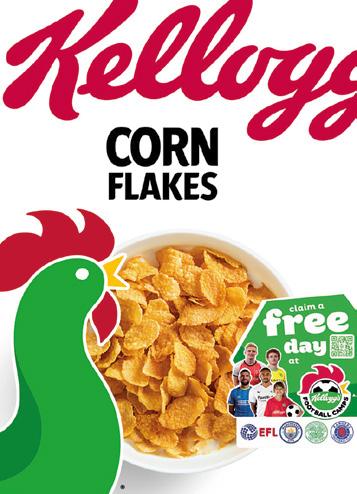
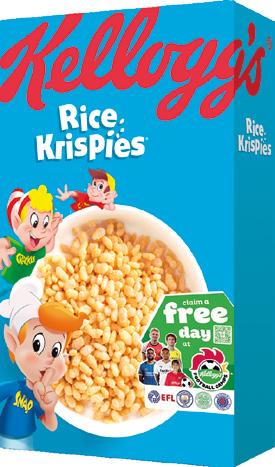
Welcome to the spring edition of Family First. In this issue, we caught up with TV presenter, Strictly Come Dancing star and dad of two, JB Gill, about life on his farm, the latest series of his children’s cooking show, Cooking with the Gills, and the second book in his Ace and the Animal Heroes series.

From spring cleaning tips to how much parents spend on birthday parties, we have also got some fantastic parenting advice, news and views from Netmums, which is a UK parenting community, welcoming and supporting millions of families every
Executive Editor: Lee Gatland
Art Director: Richard Hejsak Editor: Georgina Probert georgina@sevenstarmedia.co.uk
Deputy Editor: Becky Todd becky@sevenstarmedia.co.uk
Sales Team: 01959 543 650 sales@sevenstarmedia.co.uk
Published by SEVEN STAR MEDIA LTD 184 Main Road, Biggin Hill, Westerham, Kent Tel: 01959 543659 sevenstarmedia.co.uk

Disclaimer: Family First is published quarterly by Seven Star Media Ltd. No part of Family First may be reproduced, stored in a retrieval system or transmitted to any form without permission. Views expressed in the magazine are not necessarily those of Seven Star Media Ltd, and are included to provide advice only. No content is a substitute for professional medical advice. During printing, images may be subject to a 15% variation. © Copyright of content belongs to individual contributors with the magazine copyright belonging to Seven Star Media Ltd. All rights reserved. Please either keep this magazine for future reference, pass it on for somebody else to read, or recycle it.
day for the last 25 years. If you are thinking about booking your next family holiday, Tripadvisor has showcased some of its top-rated family-friendly hotels around the world that are geared up for big and little kids alike. Get that wish list ready! With warmer weather on the horizon, what better time to encourage your kids to try a new sport? In this issue, we have information about paddleboarding, pickleball and table tennis – all fun and exciting sports that are accessible to kids of all ages.
Wishing you a fun-filled spring, Georgina






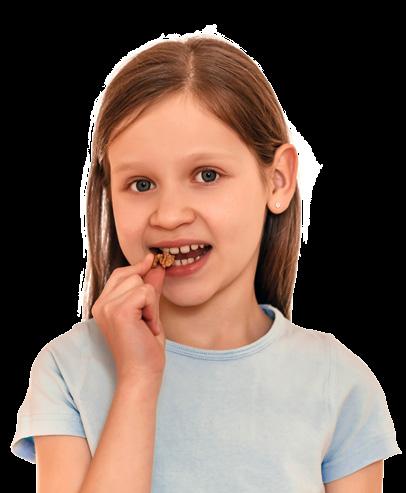
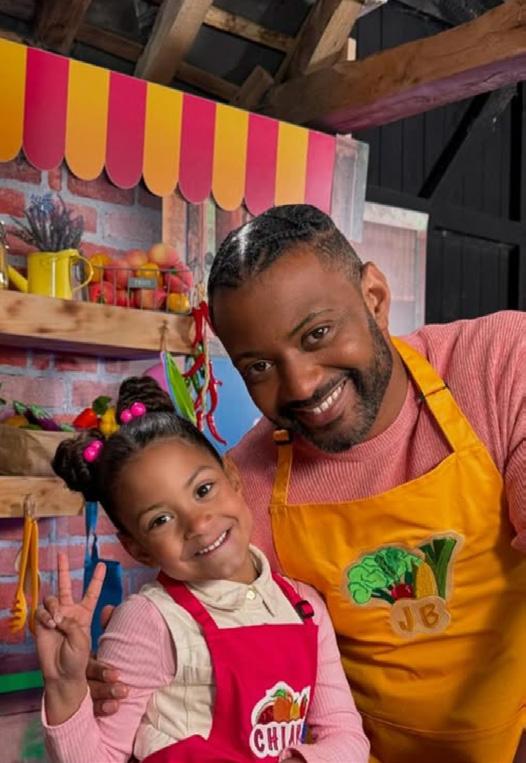





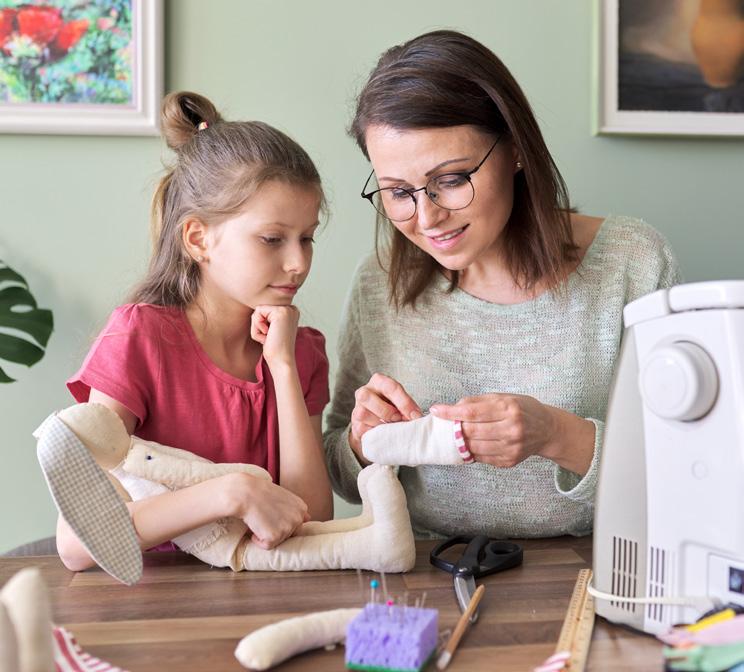



Our hand-picked selection of family-friendly items we wouldn’t be without this spring.
With the importance of looking after our planet being such a key message to share with our children, The Puppet Company has come up with an exciting way to engage our little ones. Collaborating with the global conservation company ZSL, The Puppet Company has designed backpacks with five lovable characters to support the charity, which leads conservation projects in more than 80 countries, as well as two world-leading conservation zoos. We love how these furry friends have been carefully designed to wear on the front or back, so children can enjoy a cuddle while doing their bit for the environment! Made from 45% recycled materials, with ample storage space, they’re the perfect excuse to let your little ones live life on the wild side. Animal Backpacks, £39.99, thepuppetcompany.com
ooking for something non-chocolate for the kids this Easter? The Learn To Sew Wooden Bunny Kit is the perfect choice. Not only a wonderful way to introduce children to a new skill, but also encourage the brilliant sense of accomplishment on completing something entirely new to them. Designed for children from just three years old, the kit includes everything young crafters need to create their very own bunny companion. Introducing basic stitching techniques, encouraging creativity and developing fine motor skills, the kit is the perfect choice for something a little different this Easter. We love how simple the instructions are for children to follow and how the bunny template can be used again and again. Learn To Sew Wooden Bunny Kit, £3.95, rexlondon.com

When Wild Thingz asked us if we wanted to try some ‘healthy’ gummy sweets, we were a little bit sceptical. However, once we tasted them, we were pleasantly surprised. They are not as sweet as the sugar-filled big brands, but our kids loved the fruity flavours and the range of different bugs and grubs to try (our family favourite was the Lemon maggots). Wild Thingz are 100% organic, are made from plant-based ingredients and have half the amount of sugar in them than other traditional gummy sweets. If you want to give your kids sweets, but don’t want them to have a sugar high and crash, then Wild Thingz are a great option. Wild Thingz, from £9.99 for 12 x 25g packs, wildthingz.co
Looking for an activity all the family can enjoy this Easter, well Monkey Mayhem has you covered! Suitable for up to eight players, we love how quick to learn this game is. Players must race to get the lowest hand until someone grabs the banana and then the round ends – but with a wrench literally throwing a spanner in the works it may not be so easy. This game is great for developing mental maths skills and tactical thinking. Enjoy with the whole family to find out who will truly be top banana. Monkey Mayhem, £20.00, amazon.co.uk

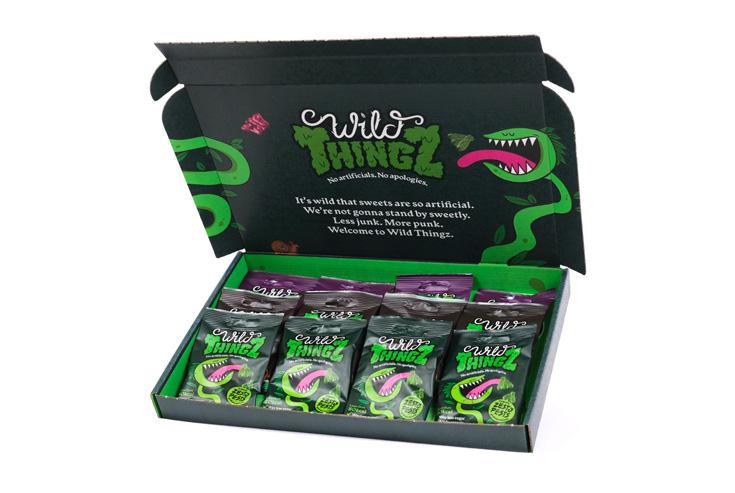
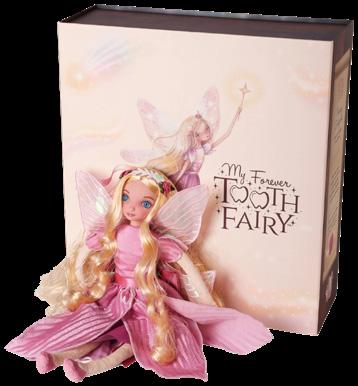
There’s nothing quite like the excitement children experience when losing a tooth! Making the experience even more memorable for children and families is ‘My Forever Tooth Fairy’: a Tooth Fairy that children can call their very own. This gift set includes a Forever Tooth Fairy doll, beautifully illustrated storybook, display case, tooth tote for tiny treasures and a fairy dictionary unlocking magical messages. With every tooth lost, children receive a special super power, such as love, confidence or friendship. We love how the focus is on empowering our children with the emphasis being off money. Plus, with everything included for parents, the timeless tradition of the tooth fairy can be a truly stress free one year after year! My Forever Tooth Fairy, £49.95, myforevertoothfairy.com



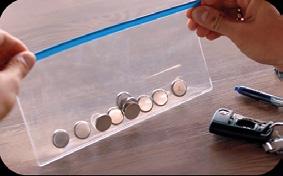



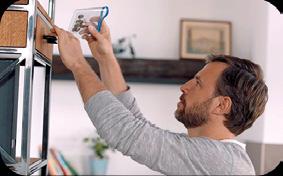


‘Conversations
and where it comes from is something that I’ve always been passionate about’
Georgina Probert caught up with former pop star, TV presenter, published author and dad of two, JB Gill, to find out about life on his farm and how he is using his platform to educate children about the origins of their food and inspire a passion for cooking.
Following a successful music career in boyband
JLS, JB Gill made the bold move of setting up a farm in the Kent countryside in 2012, where he lives with his wife, Chloe, and their children: Ace (age 10 years) and Chiara (age 6 years). Their smallholding produces KellyBronze turkeys and free-range Tamworth pork.
After such success in the world of music, what inspired you to want to move into farming?
JB:
There wasn’t one pivotal thing, if I’m honest, but I think it was a combination of a few things. I had been a part of JLS for the best part of about five years and as part of that we’re touring, travelling all over the world and promoting. It leaves very little downtime.
“I want my kids to be equipped with those skills to be able to cook and look after themselves”
As well as appearing on Countryfile, Springwatch and On the Farm, JB is a presenter on CBeebies television series, Down On The Farm, which was created for children aged 0-6 years to teach them about life on the farm and in nature.
We spoke with JB about the second series of his children’s cooking show Cooking with The Gills and the latest book in his series and the Animal Heroes.


When I left my family home, it was all about finding somewhere that I could chill, escape and be at peace. And that wasn’t necessarily with farming mind, but I wanted the quietness of the countryside or at least access to the countryside.
My mum encouraged me to buy some land that came with the with the house – at first, I had no idea what I was going to do with it!
When we decided that we were going to wind down JLS, I got to thinking about what I could do with the land. I started speaking to Adam Henson and ended up doing some work with Countryfile. We started with one pig, named Ginger, who we rescued from the RSPCA, and the farm was built from that.
farm and collect the turkeys. I think it’s great for them to have the responsibility, not just throughout the year looking after the livestock, but also learning how to interact with people and learning how to be involved in that world. It’s not to say that they’re necessarily going to go into farming when they get older, but they are all good attributes to have in life.

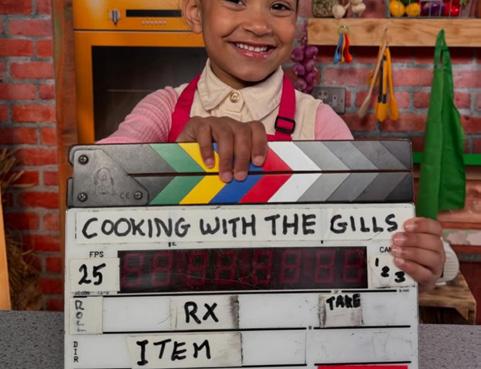
Yes, especially Ace. From those early days, he was out there helping on the farm with me. There are a couple of instances that were very much real farm life. We had our turkeys at that point and it’s always a battle trying to maintain fences to make sure the foxes haven’t got in or a deer hasn’t come and wrecked it. One day I was about to take Ace to nursery and something told me to check the farm. There were 20 or 30 birds outside of the fencing that had been killed by a fox. We ended up being late for nursery and Ace helped me pick up the dead birds. Very early on I realised that farming is actually quite full-on.
“Cooking with the Gills is all about inspiring kids and getting them enthusiastic about cooking”
The kids have always been part of that whole process. Especially nowadays, they are helping along with Chloe during our sales days at Christmas, when customers come to the





“The weather is the biggest thing to contend with as a farmer”
Do you think that because they’ve grown up in a farming environment they have a better understanding of where their food comes from and the work that goes into getting that food onto their plates?
JB:
Yeah, absolutely. I remember during lockdown, we had our chickens and we’d go down with the kids every day to collect the eggs and get the kids to count them. That’s not necessarily talking about where food comes from, but being able to use the farm as a backdrop for learning is something I’ve been incredibly passionate about for a long time and have been able to share with TV shows like Down on the Farm, which I’ve been involved in for many years now. In Cooking with the Gills and both Animal Heroes books, we talk about different types of food and how it gets to our plates.
Conversations about food and where it comes from is something that I’ve always been passionate about, as it is something that I grew up with. Coming from the Caribbean, we used to grow our own food and buy from local producers to get our everyday essentials. That’s something that I try to filter down to my children.
How do you and Chloe juggle cooking for the family along with work and life commitments?
JB:
It is hard work! You both come home and you’re tired, and then you’ve got to organise dinner.






We’re very rarely home early as the kids have various sports clubs and after-school activities, so by the time you get home, you don’t want to be cooking a gourmet fourstar meal and telling everyone about where the food comes from. But it’s incredibly important, so we try to incorporate them doing the cooking with us. Even if it is simple things like learning how to tell when pasta or rice is cooked. Or the right level of water that you need to make rice. Eventually, of course, they’re going to become adults and I want my kids to be equipped with those skills to be able to cook and look after themselves.
“Knowing when food’s done or not done, undercooked, overcooked or not putting too much salt into a dish, can take a lifetime for some people to learn, so it is good to teach kids the basics early”
We’re getting to the stage now where at the weekend, pancakes is definitely one of the most popular meals. And we always have a little secret ingredient that we put into ours (vanilla essence – don’t tell anyone!), which the kids absolutely love. During the week, I’m teaching the kids how to season chicken and cook it with some rice and vegetables. Probably one of our staples within the house is spaghetti. I always get the kids to test the pasta and know when it’s done. Things like that where the kids feel included in cooking helps them to learn.
Knowing when food’s done or not done, undercooked, overcooked or not putting too much salt into a dish, can take a lifetime for some people to learn, so it is good to teach kids the basics early.
Your kids are absolutely brilliant little TV presenters. Do they enjoy being involved in Cooking with the Gills?
Thank you. Ace has always been quite confident and charismatic. He’s been modelling since he was pretty much walking and he’s been on screen a lot in various productions. Chiara is very different to Ace. She’s a little bit more reserved. But once she gets the hang of something, she throws herself into it. This was something that came along when they were both still quite young. So in the first series, Chiara wasn’t involved as much. But now that she is a bit older, she’s fully immersed in it. I think a lot of it is to do with experience and growing your confidence. The more you do something, the better you become. It’s something that we encourage at home as well. We both come from the arts, as Chloe was a professional dancer.
And, of course, they see me on TV all the time. So it’s definitely part of our lives and something that we manage very carefully, but we encourage them to express themselves.
Can you tell us a bit more about the second series of Cooking with the Gills?
It launched on 22nd February on Saturday and Sunday mornings on Milkshake (Channel 5). It’s such a fun show because it incorporates a whole family, but genuinely, the children do all of the cooking.
By all of the cooking, I mean that they can do every single recipe (supervised, of course). They can cut, they can mix, they can scrape, they can do it all themselves. And I think that is one of the best things about it.
“Being able to use the farm as a backdrop for learning is something I’ve been incredibly passionate about”
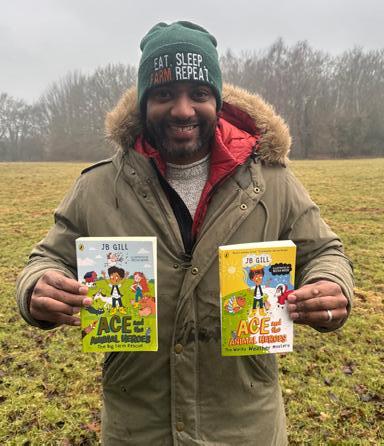

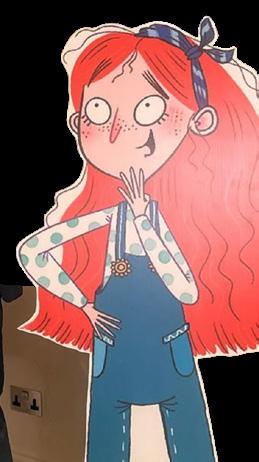

We’ve had so many messages from parents people saying, “Thanks for making my Saturday morning start even earlier” because they’ve got to get up to go and buy ingredients for whatever we’ve cooked on screen that morning. Cooking with the Gills is all about inspiring kids and getting them enthusiastic about cooking. A lot of them are simple recipes, with ingredients that you can get in your local supermarket. Then come back and you can make it together as a family, it doesn’t take long, and you’ve got a great meal at the end of it.
Can
you give us any hints on the sort of recipes that might be coming up in the new series?
One of the things that I always look forward to the most is baking. I love it, but it’s definitely not the thing that I’m best at when it comes to the kitchen. There’s an amazing blueberry cheesecake that we make in the new series. We talk about blueberries and apples and lots of different things that are grown on the farm, and then we take that into the kitchen, we cook it up and make it for the guests. The cheesecake was definitely something that I loved making, because it’s so simple and it’s one of my favourite desserts.
February was a big month for you with the release of Cooking with the Gills and your latest book Ace and the Animal Heroes: The Wacky Weather Mystery. What was the inspiration for the book?
JB:
Both of the children are characters within the book. Ace is, of course, the character Ace as that book came along just after he was born. Chiara hadn’t been born yet when we published the first book and she asked me why she wasn’t in it! In the second book, she ends up being the character Bear, which is a nickname that we have for her.
I think the biggest inspiration for The Wacky Weather Mystery was exactly as it says, the weather and some of the things that I’ve found over the years of having the farm. The weather is the biggest thing to contend with as a farmer and it’s always out of your control. It has a massive impact on the wellbeing of your livestock, how you’re able to manage the farm, what you’re able to produce, what grows well and what doesn’t grow well.
or a really hot summer.
The book is showing the difficulties that Ace, Bear and the Farm Squad have to go through in order to make sure that they can sort of meet all the deadlines and produce demands for their farm festival at the end of the book. I wanted to have a little bit of a take on something that’s a very real issue within the industry and make it accessible to the younger generation.
You’ve got lots of different work commitments, including the Strictly Come Dancing tour and you’ve got a young family and the farm. How do you manage it all?
JB:
With difficulty is the honest answer! Chloe has been instrumental in holding down the fort. Certainly, while I’ve been involved in things like Strictly. Usually, the tail end of the year
“Chloe has been instrumental in holding down the fort. Certainly, while I’ve been involved in things like Strictly
It’s a real frustration. Over the years, we’ve had some tough times, such as in October and November when it rained a lot. The turkeys are all outdoor-bred and you want to make sure that they’re still true to that lifestyle. But if the weather is too bad you have to bring them indoors. Our pigs are also outdoor-bred and we have had really hot summers, so we had to create special shelters for them to give them some shade.
While we predominantly look after livestock, I know that there are lots of farmers, growers and producers up and down the country, who have really struggled with the harvest of various different fruits and vegetables because of a cold spring (like having snow in March)
and the New Year is quieter for me in terms of entertainment and television work. A lot of my filming happens from March onwards and winds down around about October. But 2024/2025 has been completely different! I was busy from September all the way through. I’m lucky to have a network of people to support me. I was thankful to be able to finish the live show to be home in time to help with the turkey sales days.
I’ve just finished the Strictly tour now, so I’m going to be getting into all the maintenance and bits and pieces (the less glamorous bits of the farm) in the next couple of months.
For more information on JB Gill’s TV series, visit: jbgill.com
Ace and the Animal Heroes: The Wacky Weather Mysetery is available from Penguin Books: tinyurl.com/3wppb2wu

How much do you spend on your child’s birthday party? Two of our Netmums editors share their very different opinions…
“My
kid’s
parties start at around £600”
Ashley Bloem-Sale is Netmums’ Commercial Director and a mum of two. She says: “I love a party, and my kids’ birthdays give me the perfect excuse to go all out! The parties I throw are definitely on the extravagant side.
For my daughter’s third birthday, I went all-out on a rainbow theme: rainbow bagels, multicoloured plates, balloons, and cutlery, plus a DJ, two bouncy castles, and full catering. As she got older, we moved on to things like sleepover tents and hiring Babylon Park in Camden so she and her friends could go on all the rides.
For my son, I once did a full-on Paw Patrol party with character appearances, and I always make sure the party bags match the theme, though I try to avoid filling them with junk. This year, I hired the Monkey Bus, a massive ball pit that comes to your house. I also make sure the parents are taken care of, whether that’s with a stocked-up drinks station or even a cocktail truck.
I typically throw parties for around 50 people, and if I’m honest, they usually start at about £600. This year, for my daughter’s 11th, I hired out a cinema
just add personalised toppers with their name and age. I’m not spending thousands, but I do want them to see the effort I put in.”
“I have a maximum budget of £100 – you don’t need to spend more”
Louise Burke is Netmums’ Editorial Director and a mum of three. She says:
“There are many things I love about being a parent, but children’s birthday parties do not rank highly. It’s not necessarily the party itself that’s the problem for me (that’s the fun part!). It’s more the organisation, the parent Whatsapp group, the car pool, the present planning. Oh, and the cost. My kids have been to parties that must have cost hundreds of pounds. And while they’ve had a great time, I firmly believe you don’t need to spend anywhere near that much.
That’s not to say it’s easy throwing a party on a budget. In a bid to swerve three-figure costs, I once held a class party at my house during Halloween. My walls have worn a pinkish stain (cheap fake blood!) ever since. Never to be repeated.
Now my kids are older – and we’re past the stage of having to invite the whole class, phew! – I have a maximum party budget of £100. I’ve never been the parent to organise a sushi buffet, orchestrate a bearded dragon petting party in my garden, or get crafty making 24 DIY squishmallows. It’s just too much! So it’s easy to cut costs: I go for smaller groups, no party bags, bulk buy snacks and drinks and organise one joint activity. And guess what? Even on a budget, the kids still have an amazing time.”
Listen to the Netmums Unfiltered Podcast here as our panel of parents discuss birthday parties and other hot parenting topics. You can also listen on Apple Podcasts, Spotify and other streamers.

“I buy a plain undecorated cake from M&S and dress it up myself with bits from Etsy”
“I’VE
Lisa Lloyd, a mum of two autistic children, shares her struggles with the education system and her advice for parents in a similar situation.
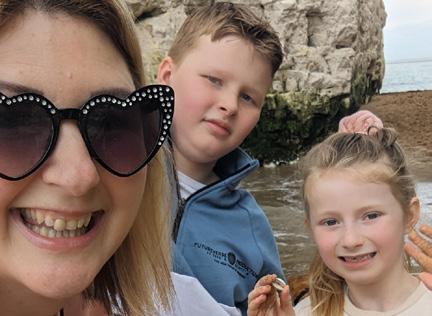
‘Slipping away in front of me’
Lisa describes how he’d “mask” in the classroom and have meltdowns at home, saying, “It was really tough. For four years the world didn’t understand him. He was saying things at a very young age that were really worrying for me – that he didn’t want to be here. I could see his personality slipping away in front of me.”
As the mum of two autistic children, TikTok star Lisa Lloyd is on a rollercoaster journey raising neurodivergent children. She’s now released a book, Raising the SEN-Betweeners, which is how she describes her children Finley, 11 and Poppy, eight. Lisa says they don’t fit in at mainstream schools and are often “forgotten about” or dismissed as naughty. Yet it took years to get support for her son. Despite him being first referred for an autism assessment when he was two, he wasn’t diagnosed for another four years. And that meant starting at a mainstream school without a diagnosis.
Finley finally received an Education, Health and Care Plan (EHCP) when he was six. This is a legal document for children who need extra support in school, and outlines their education, healthcare and social needs. With an EHCP in place, Finley was able to get a place at a SEND school.
And according to Lisa, the EHCP has ‘changed everything’. She adds, “I’ve seen my child come back to life. It’s like night and day. He even looks forward to school. I never, ever thought this day would come.”
Lisa is now sharing advice for SEN parents struggling to get the support they need from their kids’ schools. Here are her top tips:
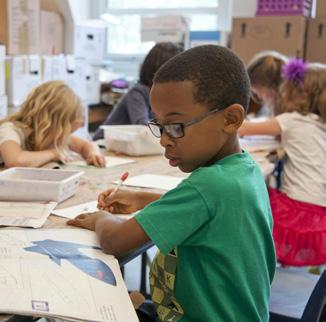
1

“It was really tough. For four years the world didn’t understand him”
Don’t be afraid to make a nuisance of yourself
If you feel that you aren’t being heard and your child is really unhappy, have meetings with the school.
2 Not all mainstream schools are the same
Some mainstream schools have better SEN provisions than others. So don’t be afraid to move schools if it comes down to it.
3 Apply for an EHCP yourself
If the school is not backing you up with the EHCP, you can apply for it yourself. This doesn’t have to be done through the school.
Lisa’s book Raising the SENBetweeners is out now. You can follow her on TikTok at @asd.with.a.g.and.t. And read the article in full on Netmums.
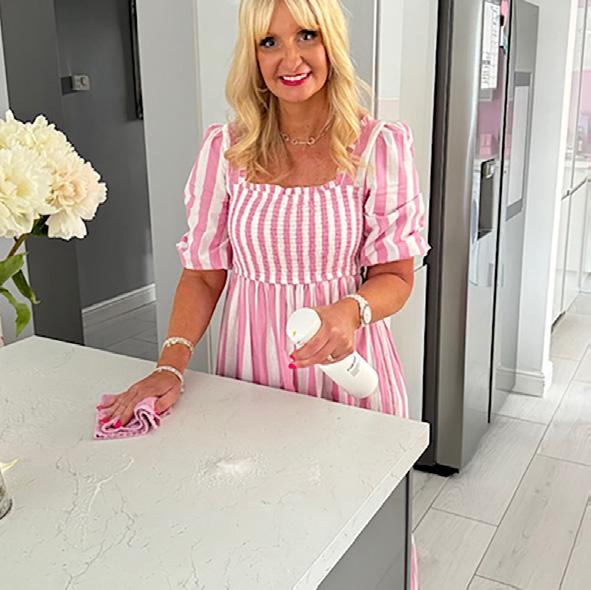
Lynsey Crombie is a This Morning expert, best-selling author and Instagram ‘cleanfluencer’.
Here are her tips for getting kids of all ages to help around the house.
Fed up with your kids making all of the mess and doing none of the cleaning up? That’s all about to change thanks to ‘Queen of Clean’ Lynsey Crombie. She shares her top tips for parents – including when kids can start helping around the house – saying, “I think you can start giving your kids little tasks when they’re around preschool age. I’ve got three children who are all grown up now and they used to have Duplo

Lego. It was quite chunky and they used to put it in the tub for me – we’d make a game out of it, but it all got tidied away.”
Here are Lynsey’s tips for making the spring cleaning a family effort:
Make it fun
Turning cleaning into a game is a surefire way to get the kids involved, says Lynsey.
“Time them doing little jobs or give them a reward like a sticker on a chart. Even if they are keeping their room tidy or just putting socks into the laundry basket, these things help.”
Getting your kids used to cleaning now will help them when they have their own home. Lynsey says, “By getting them to help, you’re teaching them values, which I think’s really important. They can set the table, they can feed the pets, they can do a bit of weeding in the garden. Give them the responsibility of their own space. It’s all teaching them that when they do eventually get their own homes, there’s not this robot that comes in and does everything. So they need to take responsibility for cleaning up themselves.”
Got older kids who are not so keen on helping out? Taking away the tech until the clean-up jobs are done really works, says Lynsey. “They are consumed by being on a tablet or a phone. If my 17-year-old doesn’t do something I ask him to do, I’m like, ‘right, Wi-Fi off’. It works!”
Lynsey also suggests letting kids earn money for cleaning. She says, “You can agree with your child if they wash the car, they’ll get a couple of quid. Or they can earn a pound for keeping on top of their room. It’s just little things, but that money adds up. If they want to go to the cinema with their friends or something, they need to earn it. If you give them pocket money anyway, make them understand the value of that money and that they’ll get it when they’ve done their jobs.”
Head to Netmums and discover our inclusive parenting community. We’ve got expert advice for every age and stage of family life. This year we’re celebrating 25 years of supporting mums and dads just like you. Find us at netmums.com or follow @netmums on Instagram, TikTok and Facebook
Follow Lynsey on Instagram, @lynsey_queenofclean

Got a parenting question and want expert help? Our Netmums Drop-In Clinic and Parent Supporter Service provides free 24/7 support and advice from health visitors, midwives, psychologists, counsellors and more. Here they answer some of the questions you’ve been asking…
My child is worried about their first school residential. How can I prepare them for being away from home?
QEmma Page is a counsellor, working with children who struggle with their mental health. She says: “It’s completely normal for children to feel anxious about being away from home, especially for the first time. Start by talking to your son about his feelings. Discuss the fun aspects of the trip and how he can stay in touch with you, through letters or phone calls, if needed. Popping a letter in his bag for him to read on the trip may help him to feel connected to you. Role play situations together that he may be nervous about, like what to do if he doesn’t know where to unpack his things or how to find the bathroom. Practice staying away from home with a night at a relative’s or friend’s
house. And give him a small comfort item, like a favourite toy or picture, to pack. Most importantly, reassure him that it’s a safe and exciting experience, and you’ll be there for him when he returns.”
QMy 2-year-old is an awful sleeper and I’m exhausted. She takes ages to settle and then wakes up between 4-5am every morning. Help!
Tracey Stone is Netmums’ resident health visitor. She says: “There are key things you can try to help her settle better and sleep for longer. Try to establish a consistent bedtime routine. Doing the same thing every evening will give her a clear message that it’s sleep time.
“Practice staying away from home with a night at a relative’s or friend’s house”
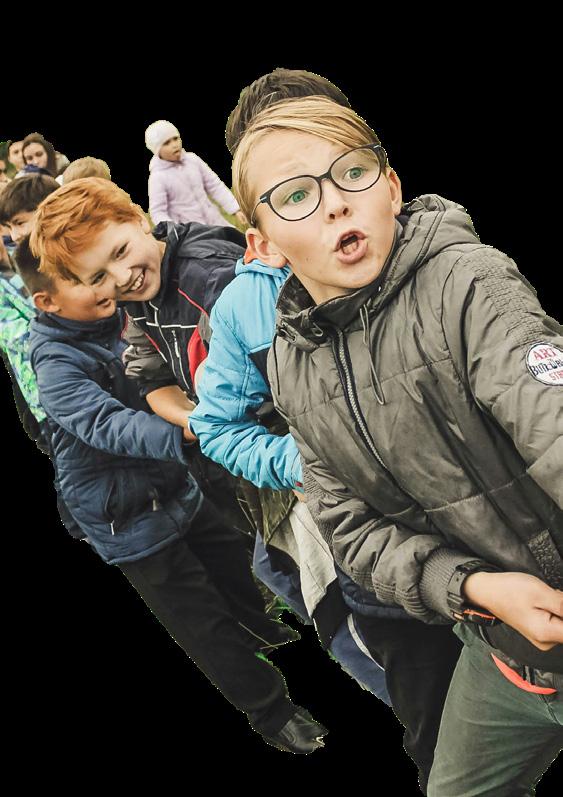



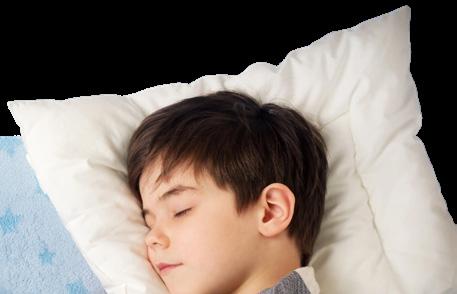

“Year 6 is a really big stage in a child’s school life and it’s understandable your son may feel worried”
that it’s calm, comfortable and dark enough for her to settle happily especially for when the clocks go forward and mornings get lighter. Check if there is anything that could be waking her up early. Screen time is known to interrupt sleep, so limiting this and balancing it with lots of daytime activities that are stimulating will encourage her to need her rest. You could build in some kind and gentle sleep training, to help her find bedtimes much more enjoyable.”
QMy son is in Year 6 and has his SATs in May. He’s really worried about them – what’s your advice?
Catherine McConnell is a social worker and supports children with their mental health. She says: “Year 6 is a really big stage in a child’s school life and it’s understandable your son may feel worried. Even if you are doing your best at home to manage any chat or pressure around exams, kids can pick up on how their peers and even teachers may be feeling. Reassuring your child that you are proud of him no matter what is a great place to start. If possible, stick to the usual daily routine focusing on the basics of eating and sleeping well as this can help us all when we feel anxious. Practising breathing exercises together can help manage any physical symptoms of worrying. If your child finds talking about their feelings hard, they may find a journal or a worry monster helps.”





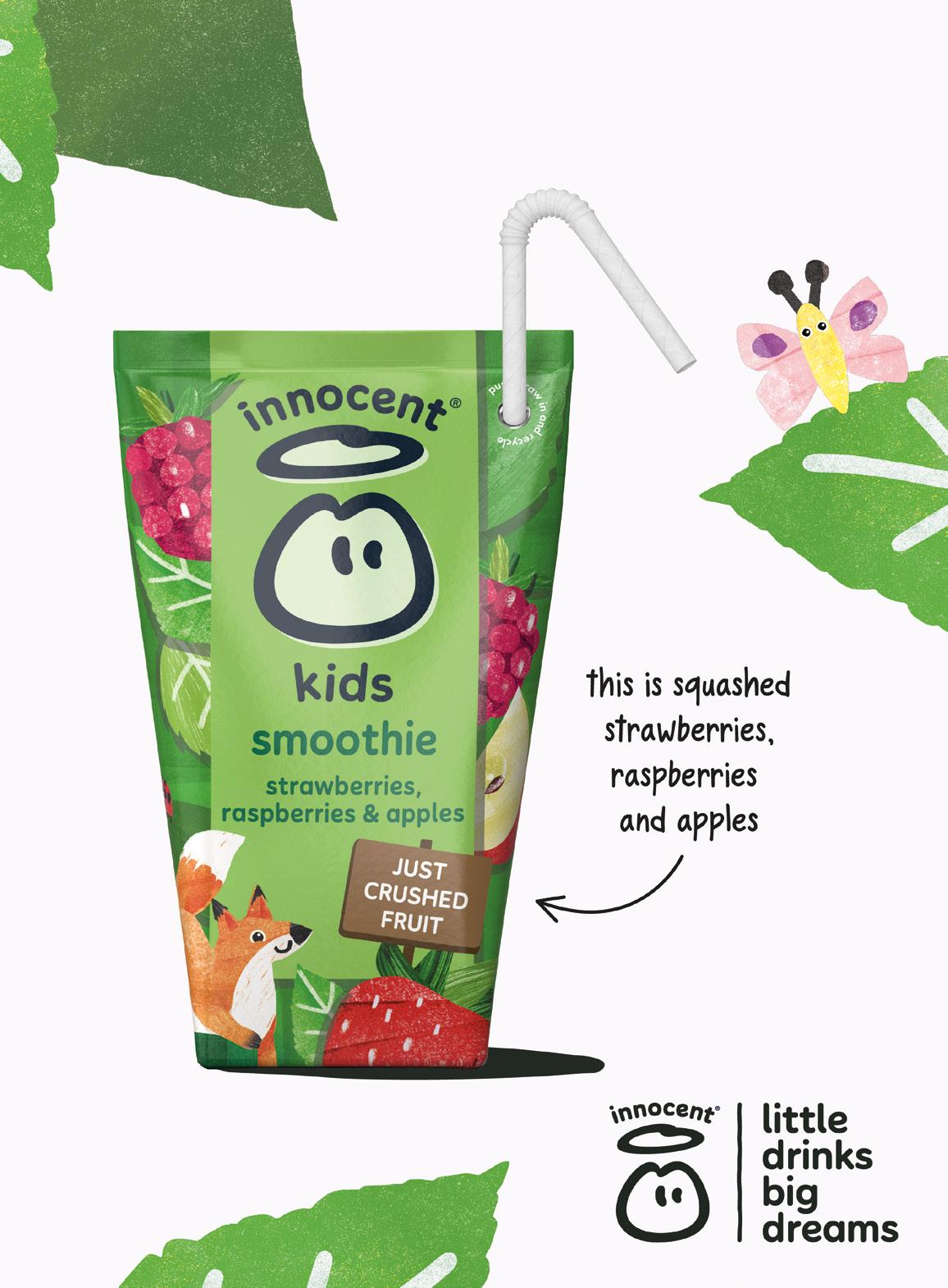
Heading abroad as a parent can be stressful. There are outfits to be planned and suitcases to be dug out of the loft, not to mention all the other holiday admin such as finding passports and collecting currency.
But one thing you should be thinking about before you head for the sun is travel insurance. Because, as you know, travelling with little ones can bring up plenty of unexpected twists.
From sudden illnesses that mean cancelled plans to lost gadgets or even luggage, it can all add up – especially if you’re not covered. But don’t let any of these worries spoil your family’s escape plans.
Get holiday ready with Post Office Travel Insurance. Request a quote today at postoffice.co.uk/travel-insurance
†Under 18s travel for free providing they have no medical conditions. *For more information, visit postoffice.co.uk/travel-insurance/medical-assistance **Customers who

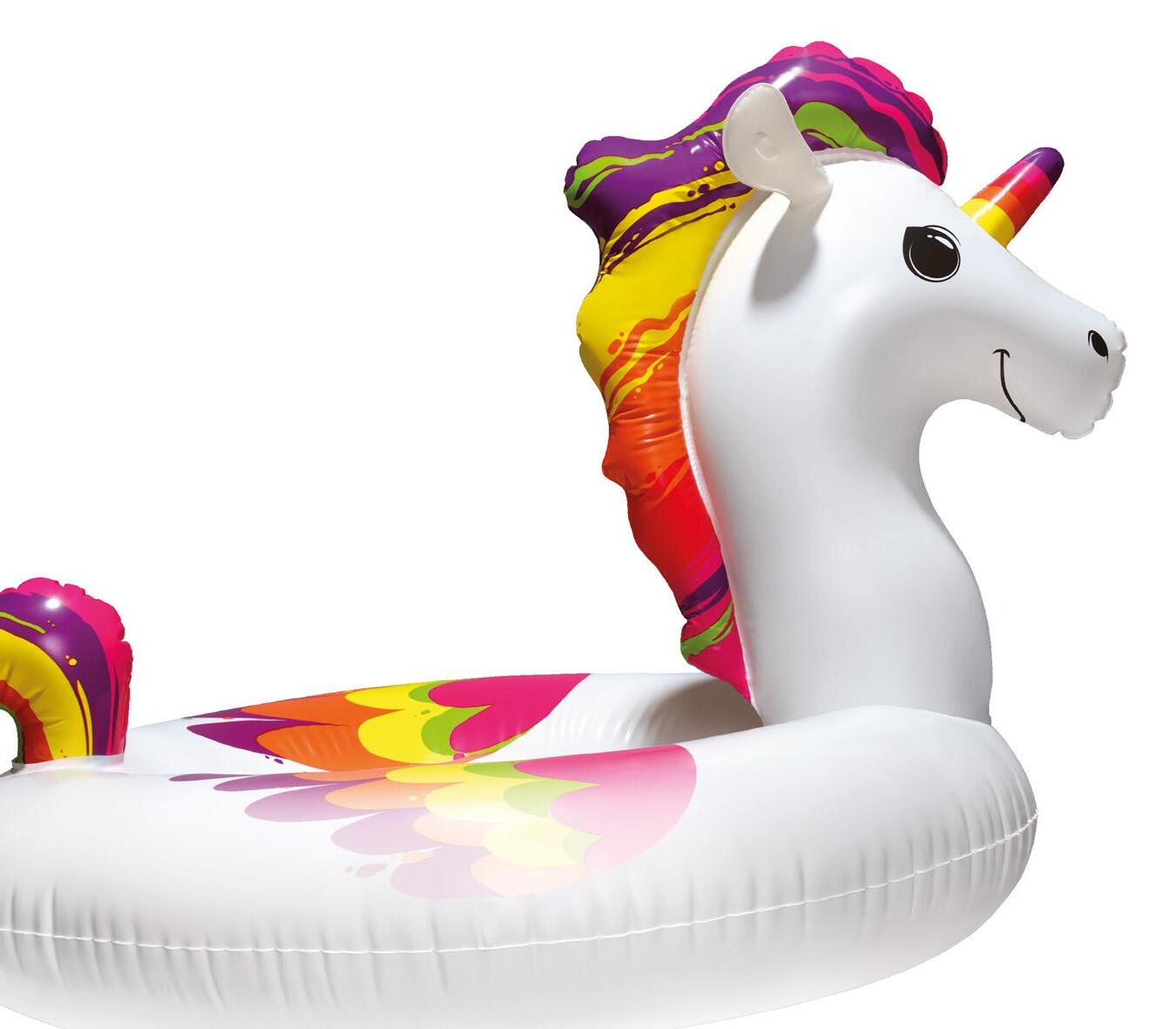
all Post Office Travel
Use the code online or through our contact centre to get 10% off travel insurance, whether you

after even more away

5
reasons to protect your family abroad with Post Office Travel Insurance

three levels of cover
Economy cover offers great value for cost-conscious families. And for those wanting peace of mind, our Premier protection comes with a 5-star Defaqto rating.
We all know what kids are like with gadgets… you can protect them all by adding You can also add trip disruption cover, and more.
Powered by Air Doctor, you’ll get 24/7 access to medical support while you’re abroad. It’s included on all our policies and
Travel Money | Insurance | Passport
We can help with that
Tripadvisor highlights some of its top-rated family friendly hotels giving you inspiration for your next family break.
Every year, Tripadvisor’s Travellers’ Choice Awards showcase the very best destinations, beaches, hotels, restaurants and experiences in the world, according to global travellers. Travellers’ Choice Awards: Best of the Best Hotels are the most highly rated stays, as fewer than 1% of Tripadvisor’s 8 million listings reach this milestone. Based on more than 1 billion reviews and opinions, the best family friendly hotels are travellers’ top recommended hotels in the world, tried and tested – chosen by families, for families.
MARAGOGI, BRAZIL tinyurl.com/5n735ea5
Tucked away in the laid-back town of Maragogi, where mangroves meet sandy white beaches, is Salinas Maragogi All Inclusive Resort – and according to Tripadvisor reviewers, this is the best family friendly hotel in the world, taking the No. 1 spot in their most recent awards. With watersports like paddle boarding and canoeing, tennis courts, multiple swimming pools, waterslides and a kids club with activities for younger kids and teens, this is a great getaway for all the family. With more than 12,000 reviewers rating it ‘excellent’, multiple visitors to this tropical family resort have called it ‘paradise’.
1 2


JAVA, INDONESIA
tinyurl.com/nhevvcy9
On the tropical island of Java, nestled on the slopes of the Arjuna Mountain, you’ll find the Baobab Safari Resort. With its picturesque setting, spectacular views and its very own onsite safari park, this is a real bucket list stay. There’s plenty of activities for kids, from breakfast with a potential visit from the resident giraffes, to storytelling round the campfire and special wildlife walks. There’s also plenty of exploring to be done around the island, with the best



BELEK, TURKIYE
tinyurl.com/3t3dvfnm
Another family favourite is the Voyage Belek Golf & Spa resort, just a 45-minute drive from Antalya airport. There is plenty to keep the little ones entertained, with its own waterpark, fairground rides and playgrounds. The adults won’t miss out either, as the resort boasts its own golf course, adult pool and private beach access and spa, which can be enjoyed as the kids while away the hours in the kids club. This 5-star hotel is praised by visitors for its spacious rooms, great service and wonderful food and has plenty of return guests.


DUBAI, UAE
tinyurl.com/2e7a88js


3 4 5
LERMOOS, AUSTRIA
tinyurl.com/5n7836we
The Alpenrose is a luxury ‘Kinderhotel’, specifically designed with families in mind, guaranteeing an enriching and relaxing experience for all. With specialised childcare and activities for children from babies through to teens, parents will have plenty of time to relax in the spa or take advantage of all the beautiful surroundings. This is a mountain escape with a focus on adventure and the outdoors. Whether it’s skiing, climbing or canyoning, playing a game of tennis or a round of golf, there will be no chance of anyone claiming to be ‘bored’.
This 5-star luxury resort with 1.2km of private beach and skyline views is everything you would expect from a Dubai hotel and more. The beautiful beach-front garden has multiple swimming pools, its own waterpark, as well as access to watersports and a softplay. Guests claim the kids club is one of the best they’ve seen and said across the resort, the service is unmatched. With over six bars and restaurants to choose from onsite, you’ll be spoilt for choice!

tinyurl.com/45vjcfka
On the Kassandra peninsula of mainland Greece, Porto Sani offers families luxurious accommodation in a stunning setting. Enjoy white sand beaches, lapped by the topaz Aegean Sea, with a complimentary beachside childcare service available so you can take a dip yourself. The Creche and Kids Club are open seven days a week and the Teen House has activities on offer for ages 12-17 from dance classes to scuba-diving, giving them a chance to make new friends and have some fun. Multiple restaurants across the resort offer traditional Greek cuisine, as well as Spanish, French, Peruvian and Japanese restaurants serving up fresh seafood and local produce.

6

Tripadvisor, the world’s largest travel platform, helps millions of people each month become better travellers. Find out more about Tripadvisor’s Travellers’ Choice Awards (tripadvisor. co.uk/TravelersChoice), Travellers’ Choice Awards: Best of the Best Hotels (tripadvisor. co.uk/TravelersChoiceHotels), Best of the Best FamilyFriendly hotels (tripadvisor. co.uk/TravelersChoiceHotels-cFamily-g1).
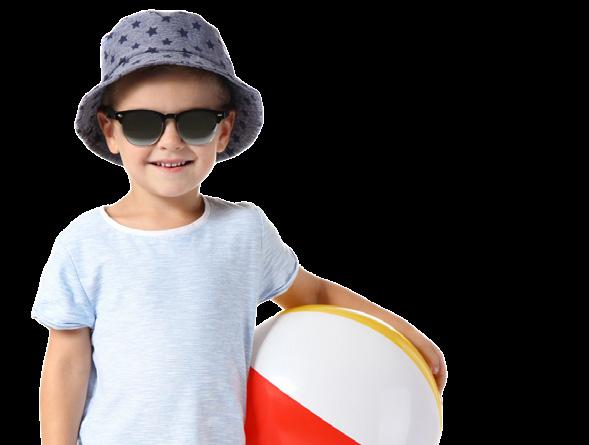
Lining up large pools, kids’ clubs and food for everyone, TUI BLUE family hotels have all bases covered…
TUI BLUE Manar †
Hammamet, Tunisia
This huge hotel majors in quality time with the clan. There’s a waterpark with twisting slides, four pools to dip in and out of and an activity roster that includes canoeing, archery and volleyball. Showing off a new look after its refurb last summer, take your pick of a bunch of rooms at the TUI BLUE Manar, including a swim-up option that fits six people and a double room with a kids’ den. Fancy a family day out?

You’re only a 10-minute taxi ride from Hammamet – a hotspot for bagging bargain spices and souvenirs at the souks and tucking in to fresh Brik, the Tunisian take on the Cornish pasty.

Dalaman, Turkey
Kids’ pools are common at most family-friendly hotels, but TUI BLUE Tropical takes it to the next level with four that are just for tots. For grownups, there’s a relaxation pool, so you can clock up some chill time while the little ones are busy at the TUI Kids’ Club. The dining set-up? Top. Notch. There are five restaurants, including a separate area in the main restaurant where kids can plate up whatever they like. Psst! Don’t forget to ask Guest Relations about the Children’s Healthy Eating Challenge – they get stickers to add to their lanyard for every new healthy dish they try. For a change of scene, take a seat in one of the four à la carte restaurants – there’s a Turkish and an Italian to try.
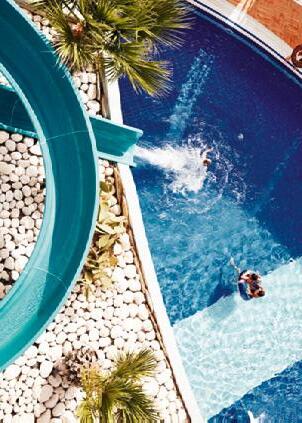
TUI BLUE Mai Khao Lak†
Khao Lak, Thailand
TUI BLUE Mai Khao Lak† Khao Lak, Thailand
Think Thailand is all about buzzing cities? Think again – the island of Khao Lak is in the business of recharging batteries. Tucked away on Thailand’s southwest coast, TUI BLUE Mai Khao Lak boasts family-friendly features, like a pirate ship-themed splash park, firstclass kids’ clubs for tots and teens and a big list of activities – all with a sandy stretch a few steps from the hotel’s door. Grown-ups get their holiday fix here, with an adults-only pool, a relaxing spa* and a gym. Feeling hungry? There are six restaurants to keep everyone happy, including a buffet area for children and a speciality Thai restaurant, where local flavours fill the menu.
Think Thailand is all about buzzing cities? Think again – the island of Khao Lak is in the business of recharging batteries. Tucked away on Thailand’s southwest coast, TUI BLUE Mai Khao Lak boasts family-friendly features, like a pirate ship-themed splash park, firstclass kids’ clubs for tots and teens and a big list of activities – all with a sandy stretch a few steps from the hotel’s door. Grown-ups get their holiday fix here, with an adults-only pool, a relaxing spa* and a gym. Feeling hungry? There are six restaurants to keep everyone happy, including a buffet area for children and a speciality Thai restaurant, where local flavours fill the menu.



TUI BLUE Atlantica Aegean Park
TUI BLUE Atlantica Aegean Park
Kolymbia, Rhodes
Kolymbia, Rhodes

Sealing itself as a firm family favourite, TUI BLUE Atlantic Aegean Park appeals to all ages, thanks to a waterparkcome-splash park, a TUI Kids’ Club and a wellness centre that’s just for adults. The main outdoor lagoon-style pool boasts a swim-up bar, and there’s a separate swim spot indoors. Like a packed activity agenda? From football and basketball to yoga classes and Aqua Fit, this place has loads to choose from. Gather your group and join the family activity sessions, where games, arts and crafts and challenges take centre stage for one hour, up to three times a week. Mealtimes are family-orientated, too. The buffet restaurant has large tables designed for families and a spot for little ones to choose what goes on their plate. If traditional is more to your taste, the taverna-style à la carte Greek eatery is a must-try – meze, anyone?
01 Start your holiday sooner, with flights from over 20 UK airports.
01 Start your holiday sooner, with flights from over 20 UK airports.
02 Stay in a hotel designed for the whole family.
02 Stay in a hotel designed for the whole family.
03 Bag a free kid’s place, even in the school summer holidays.**
03 Bag a free kid’s place, even in the school summer holidays.**
04 Tailor your trip to you, with a range of flight options and holiday durations.
04 Tailor your trip to you, with a range of flight options and holiday durations.
05 Book Happy on our app, website, or in-store.
05 Book Happy on our app, website, or in-store.
To check out the full range of familyfriendly TUI BLUE Hotels, look for the Family Fun highlight while you’re searching for your dream getaway at tui.co.uk
To check out the full range of familyfriendly TUI BLUE Hotels, look for the Family Fun highlight while you’re searching for your dream getaway at tui.co.uk
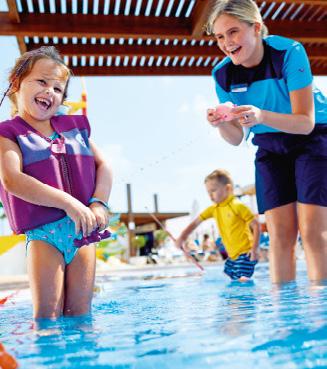
06 Call, message or face-to-face – we’re here for you 24/7, every step of your holiday.
07 Beaches, city breaks, cruises? You name it, we’ve got it, so you can holiday your way.

Sealing itself as a firm family favourite, TUI BLUE Atlantic Aegean Park appeals to all ages, thanks to a waterparkcome-splash park, a TUI Kids’ Club and a wellness centre that’s just for adults. The main outdoor lagoon-style pool boasts a swim-up bar, and there’s a separate swim spot indoors. Like a packed activity agenda? From football and basketball to yoga classes and Aqua Fit, this place has loads to choose from. Gather your group and join the family activity sessions, where games, arts and crafts and challenges take centre stage for one hour, up to three times a week. Mealtimes are family-orientated, too. The buffet restaurant has large tables designed for families and a spot for little ones to choose what goes on their plate. If traditional is more to your taste, the taverna-style à la carte Greek eatery is a must-try – meze, anyone? *Extra charge. **Free kids’ places are available on selected holidays and are subject to availability. Only one free kid’s place is available per room or airport, with two full-paying adults. You must pay the full price for any other children on the booking. †This hotel only comes with the Family Fun highlight from April to November – some facilities will be unavailable if you travel outside of this time.
06 Call, message or face-to-face – we’re here for you 24/7, every step of your holiday.
07 Beaches, city breaks, cruises? You name it, we’ve got it, so you can holiday your way.
What to expect at all TUI BLUE hotels with the Family Fun highlight…
What to expect at all TUI BLUE hotels with the Family Fun highlight…
From baby equipment hire to fun challenges like family Olympics, it’s safe to say these hotels have got family-friendly holidays covered. There are BabyClub & Parent and Baby sessions for tots aged 0 to 36 months and TUI Kids’ Clubs for kids aged 3 to 12. Swim School* opens from 6th June to 31st August, plus fitness activities for the whole family thanks to the #BLUEf!t®ForFamilies programme.
From baby equipment hire to fun challenges like family Olympics, it’s safe to say these hotels have got family-friendly holidays covered. There are BabyClub & Parent and Baby sessions for tots aged 0 to 36 months and TUI Kids’ Clubs for kids aged 3 to 12. Swim School* opens from 6th June to 31st August, plus fitness activities for the whole family thanks to the #BLUEf!t®ForFamilies programme.
*Extra charge. **Free kids’ places are available on selected holidays and are subject to availability. Only one free kid’s place is available per room or airport, with two full-paying adults. You must pay the full price for any other children on the booking. †This hotel only comes with the Family Fun highlight from April to November – some facilities will be unavailable if you travel outside of this time.
KIDS CRUISE FROM £99
SCAN HERE FOR MORE DETAILS
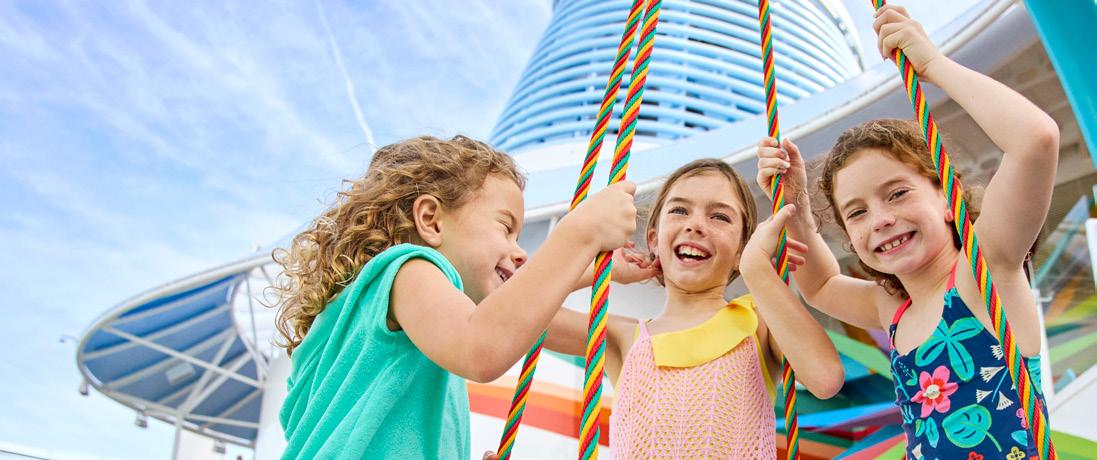



From dawn to dusk, the ship becomes the best playground ever filled with games, events, and activities, transforming family time into an extraordinary adventure.
WHY ROYAL CARIBBEAN?
ACCOMMODATIONS DESIGNED WITH EVERYONE IN MIND FULL BOARD DINING
AWARD-WINNING ENTERTAINMENT
COMPLIMENTARY ADVENTURE OCEAN® YOUTH PROGRAM
POOL DECK WITH WHIRLPOOLS & LIVE MUSIC
SPLASHAWAY BAY TM AQUA PARK FOR TOTS TO TWEENS
SPA & FITNESS CENTRE
UNPARALLELED PERSONAL SERVICE
The complimentary, award-winning Adventure Ocean® Youth Program ensures that kids and teens are immersed in a world of engaging and educational activities that fuel their creativity. The Adventure Ocean staff are not only multilingual but also exceptionally qualified in childcare, including children with autism, special needs, and disabilities. Royal Caribbean take pride in offering programs tailored to different age groups, ensuring an enriching experience for every child.
BOOK YOUR 2025/2026 ROYAL CARIBBEAN CRUISE TODAY!
Enter Legend of the Seas - shaking up summers in Europe to iconic levels. Royal Caribbean has changed holidays forever, bringing families of all ages together every way to play for maxed-out memory making and bolder bonding. From adrenaline pumping thrills like the largest waterpark at sea, to 7 pools for every mood, mind blowing entertainment, and over 40 ways to dine and drink.















































































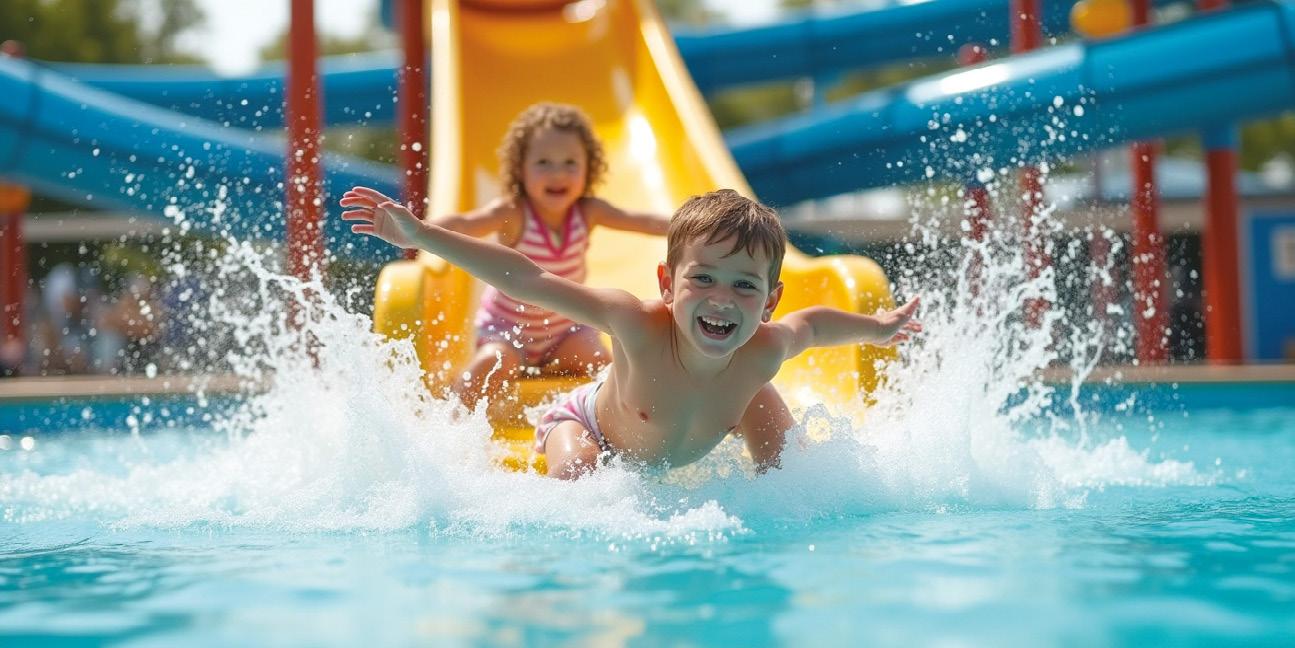
Georgina Probert spent four days in Crieff, Scotland with her husband and two daughters (aged four and nine) exploring the area to give you the low-down on the best family-friendly things to see and do.
Nestled in the heart of Scotland, Crieff is a charming town in Perthshire that offers a blend of natural beauty, historical landmarks and engaging activities for families of all
ages. Whether you’re visiting for a short break or planning a longer holiday, Crieff offers a wealth of attractions and experiences that are perfect for families. From scenic walks to animal encounters and historical exploration, there’s something to keep every member of the family entertained.
We visited Crieff in December and stayed at Braidhaugh Holiday Park. A few minutes’ walk from Crieff town centre, this was the perfect base to explore the local area. We stayed in a Contemporary Two-Bedroom Lodge, which was a lovely cosy space that had everything we needed during our stay, including a small kitchen, lounge/ dining area, two bedrooms and

“Crieff is surrounded by some of Scotland’s most beautiful landscapes”
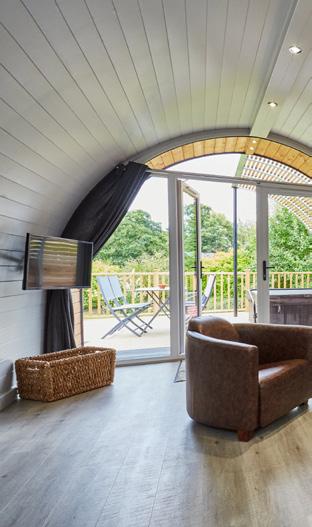
a bathroom with walk-in shower, as well as a decking area with a hot tub. We loved how spacious the lodge was, with plenty of room to accommodate all of the kids toys and a big enough sofa area for all four of us to use at the same time.
Braidhaugh Holiday Park has a range of accommodation options, including Traditional Two-Bedroom Lodges (some with hot tubs and some without), Riverside Lodges with Spa Pool, Premium Glamping Pods with Hot Tub, Superior Ensuite Pods with Electric Tub, Superior Ensuite Pods with Wood-Fired Tub and Static Caravans. The park also has spaces for tent and caravan pitches.
The Main Reception is open seven days a week and has a small shop selling basic essentials. It also houses the Courtyard café, which has a range of breakfast options, sandwiches, soups, salads, burgers, baked potatoes and sweet treats.
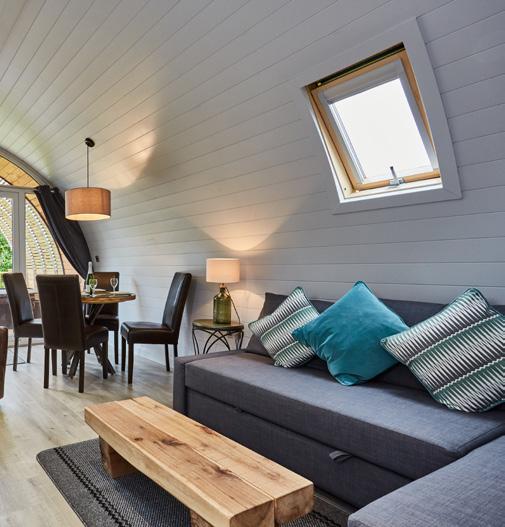
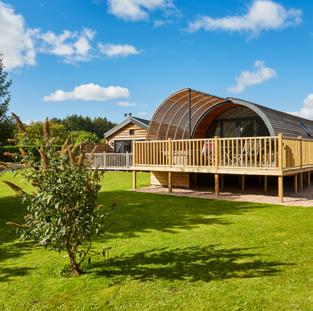

Dogs are welcome at the park and there is a field and playpark right next door for animals and kids to enjoy.

For families who enjoy the great outdoors, Drummond Castle Gardens is an absolute must-see. Often described as one of the most important Renaissance gardens in Scotland, these stunning grounds boast manicured hedges, ornamental fountains and vibrant flower beds. Families can stroll through the garden, marvelling at its design and let the kids explore the wideopen spaces. The garden is also home to some interesting wildlife, including birds and butterflies, which children will enjoy spotting.
The gardens are located just outside the town, offering plenty of space for a relaxing day out. It’s also an excellent spot for a picnic, with a café serving delicious refreshments nearby.
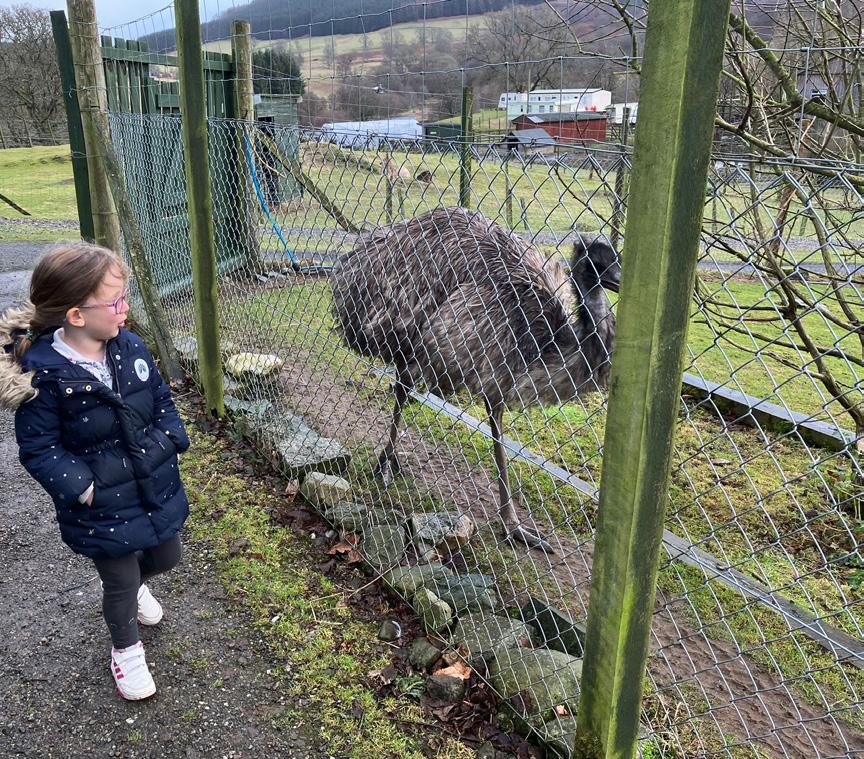
Situated just a short distance from the town centre, the Crieff Visitor Centre is a fantastic place to begin your exploration of the area. This familyfriendly destination offers a variety of activities, including a large adventure playground. The visitor centre also provides educational displays about the local history and wildlife of Crieff and the surrounding area.
For animal lovers, there’s an opportunity to meet and interact with animals at the nearby farm, where families can see animals such as pigs, goats and sheep. The centre also hosts workshops and seasonal events, so it’s worth checking the schedule to see if any special activities coincide with your visit.
MacRosty Park is an excellent green space in the heart of Crieff, ideal for families who enjoy outdoor activities. The park features a children’s play area with swings, slides and climbing frames, as well as extensive lawns for picnics,

ball games and general relaxation. The park is also home to a beautiful stream, with a charming stone bridge and plenty of shaded areas perfect for a peaceful family walk.
The park is dog-friendly, so families with pets can also enjoy a leisurely stroll through the grounds. Additionally, the park is a popular spot for local families to gather, and it often hosts seasonal events, such as open-air concerts, which can add a fun element to your visit.
For families seeking a more adventurous experience, Crieff Hydro is one of Scotland’s premier family-friendly
resorts. Set within 900 acres of land, the centre offers a vast array of outdoor activities, ranging from horse riding to mountain biking, archery and even offroad driving. There’s something for every family member, with activities designed for all ages and abilities.
Children can enjoy horse riding lessons, learn to canoe or take part in a family-friendly treasure hunt. Parents, too, can unwind with spa treatments or relax in the resort’s luxurious facilities. The wide range of activities means that both parents and children will have ample opportunities to explore and enjoy nature while trying new things.
“Braidhaugh Holiday Park was the perfect base to explore the local area”
A 15-minute drive from Crieff, Auchingarrich Wildlife Centre is an excellent choice for families with young children. This wildlife park is home to a variety of animals, including meerkats, wallabies, deer, owls and more. The park has a hands-on approach to animal care and there are opportunities for children to get close to some of the animals, making it an educational and fun experience for all ages. Our youngest daughter loved spotting all of the animals and getting up close and personal with the cage and aviary birds that live in the centre’s café.
In addition to the animal exhibits, the wildlife centre offers a soft play area, café and nature trails, ensuring there’s something to entertain children both indoors and outdoors. The park is particularly popular for its interactive experiences, including the chance to feed the animals, so it’s sure to be a hit with little ones.
For families interested in history, The Strathearn Museum in Crieff offers a fascinating insight into the town’s past. The museum features exhibits on
Crieff’s role in the local wool trade, the history of the railway and the town’s connection to the Clan MacRae. It’s a great way to introduce children to Scotland’s rich history, with interactive displays that bring the past to life.
The museum is small but offers a hands-on experience, with educational exhibits that can spark conversation and learning. For children interested in Scottish heritage, it’s a valuable stop that helps them understand the historical context of the town they’re visiting.
Crieff is surrounded by some of Scotland’s most beautiful landscapes, offering a variety of walking and cycling trails that are perfect for families. The area is home to several scenic routes suitable for all ages and abilities. Families can explore the rolling hills, dense woodlands, and tranquil lochs on foot or by bike, taking in the stunning views of the countryside.
A popular route is the walk to the top of the Knock of Crieff, a hill that offers panoramic views of the town and the surrounding area. The walk is suitable for children and adults alike, and the summit provides an excellent spot for a picnic or a photo opportunity.
For cycling enthusiasts, Crieff offers a number of cycle routes, ranging
from easy paths to more challenging terrain, making it a great destination for families with older children or those looking for a bit of adventure.
No family trip is complete without some downtime to browse local shops and enjoy a meal together.

“Auchingarrich Wildlife Centre has a handson approach to animal care”

Crieff boasts a variety of independent shops and cafés, perfect for families looking to unwind. The town’s High Street is lined with boutique shops selling everything from handmade crafts to locally produced goods, ideal for picking up souvenirs.
For a family-friendly meal, there are numerous cafés and restaurants offering Scottish delicacies and international cuisine. Many places are child-friendly, offering kids’ menus, high chairs and even special activities for younger visitors.

Crieff offers a wide array of familyfriendly activities that cater to all ages and interests. Whether you’re exploring stunning gardens, getting up close with wildlife or enjoying outdoor adventures in the beautiful Perthshire countryside, there’s no shortage of things to see and do. The town combines natural beauty, historical charm and a wealth of family-friendly attractions, making it the perfect destination for a family getaway. Whether you’re planning a relaxing weekend or an action-packed holiday, Crieff is sure to provide unforgettable memories for the whole family.
For more information on Braidhaugh Holiday Park, visit: largoleisure.co.uk/ holiday-parks-scotland/braidhaughholiday-park


Save on the cooking and pennies this Easter! Family First rounds up the best places in the UK that kids can eat for free during the school holidays.
The Easter holidays are a time for families to relax and enjoy spending quality time together, but with endless activities to entertain little ones, they can quickly add up… especially when it comes to eating out. Fortunately, many restaurants have come to the rescue with ‘Kids eat free deals’, running throughout the Easter holidays, so you can enjoy dining out without worrying about breaking the bank.
Whether you’re looking for a big breakfast, light lunch or delicious dinner, we’ve rounded up the best ‘kids-eatfree’ deals to make sure both your wallets and appetites are satisfied this Easter.









Angus Steakhouse - Kids (under 8) eat free with a full paying adult dining on a main course, available everyday from 12pm-5pm. Not applicable on Saturdays in Bond Street, and Oxford Circus branches. The Kid’s Menu also comes complete with an activity sheet and colouring crayons to keep the little ones happy! Find out more: angussteakhouse.co.uk/kids-eat-free
Beefeater Grill RestaurantTwo kids (under 16) get a free unlimited breakfast with every adult breakfast purchased. Find out more: beefeater.co.uk/en-gb/school-holidays
Bella Italia - Kids (age 2-11) can enjoy a free meal, all day, every Thursday and for just £1 until 6pm, Sunday-Wednesday when an adult meal is purchased. They also offer a colouring sheet to keep the little ones entertained! Find out more: bellaitalia.co.uk/kids
Bills - Up to two kids can eat free all day (excluding Saturday and Sunday), if one adult orders any main dish (breakfast, lunch or dinner), from 7th - 25th April. Find out more: bills-website.co.uk
Brewers Fayre - Up to two kids (under 16) can eat a free breakfast with any purchase of a £10.99 adult unlimited breakfast. Find out more: brewersfayre.co.uk/en-gb/schoolholidays
Dobbies Garden Centres -
Enjoy a free children’s breakfast with any adult traditional or full breakfast or a free child’s hot meal or pick n mix lunch box with any adult main course. This offer is available every day and also includes a free child’s drink. Find out more: dobbies.com/ restaurants/offers
Future Inns - In the Bristol, Cardiff and Plymouth restaurants, kids (under 5) eat for free with any adult meal (including breakfast, lunch and dinner). Find out more: futureinns.co.uk/ special-offers/kids-eat-free-at-future-inns/
Gordon Ramsey RestaurantsKids (under 8) eat a free main course at selected restaurants with a purchase of an adult meal from the a la carte menu. Find out more: gordonramsayrestaurants.com/ whats-on/kids-eat-free-at-gordon-ramsayrestaurants/
Las Iguanas - Download the ‘My Iguanas’ app and kids (under 12 years old), get a free main course, two sides and a desert with every adult ordering a meal from the a la carte menu. One app perk can be redeemed per table. Find out more: iguanas.co.uk/kids-menu/









Morrisons Cafés - Kids (under 16) eat one free meal from the customer café when an adult buys a meal over £4.50. Find out more: my.morrisons.com/kids-eat-free---tscs/

Pausa Cafés at Dunelm - All day, every day, for every £4 spent by an adult in the cafe, kids can enjoy a free mini meal deal (includes a main, two snacks and a drink). Find out more: dunelm.com/info/about/pausa-coffee-shops

Pizza Express - Kids ( up to 12 years old), eat free with every adult main meal ordered. This includes a children’s starter, main & desert! This offer is running from 7th March- 24th April. Find out more: pizzaexpress.com/offers

Premier Inn - Two kids (under 16) can eat breakfast for free with every adult purchase of a full breakfast or meal deal. Find out more: premierinn.com/gb/en/why/food/breakfast. html
Preto - Kids (under 10) can eat for free all day at the weekend and every weekday from 4pm with a paying adult. Find out more: preto.co.uk/ offers/children-eat-free
Prezzo - Kids (under 12) can eat a 3-course meal for free anytime at selected locations from 31st March - 27th April with every full paying adult meal. Find out more: prezzo.co.uk/about/ kids

Purezza - Children (under 10) get a free mini pizza with every adult meal purchased – all day, every day. Find out more: purezza.co.uk/ kids-eat-free/
Table Table - Two children (under 16) can get a free breakfast every day when one adult purchases an unlimited breakfast for £10.99. Find out more: tabletable.co.uk/en-gb/ breakfast
Tesco Cafés - Choose a kid’s sandwich, piece of fruit, two snacks and a drink for free with any adult purchase in a Tesco Café. Find out more: tesco.com/zones/tesco-cafe/kids-menu
TGI Fridays - If you are a Stripes Rewards Member, kids can eat free all day every day when a full-priced adult main meal is purchased. Find out more: tgifridays.co.uk/ offers/kids-eat-free
The Real Greek - Kids (under 12) eat free every Sunday when an adult spends £15. Find out more: therealgreek.com/offers/
Travelodge - Two kids (age 15 or under) can eat breakfast for free for every full paying adult at selected locations. Find out more: travelodge.co.uk/about/breakfast/

Whitbread Inns - Up to two kids (under 16) eat free with one full paying adult breakfast (£20.99). Find out more: whitbreadinns.co.uk/en-gb/school-holidays




Asda Cafes - Kids ( under 16), enjoy a hot meal for £1 all day every day, all year round with no adult purchase necessary . A free piece of fruit is included with all kids’ hot meal deals as part of the deal. Find out more: asda.com/ instore/cafe
Hungry Horse - Kids eat for £1.00 every Monday with every full paying adult meal. Find out more: hungryhorse.co.uk/deals/ kids-eat-for-1
IKEA - Kids can enjoy pasta with tomato sauce, a soft drink and a piece of fruit for 95p. Find out more: ikea.com/gb/en/stores/ restaurant/#3df03080-2e86-11ed-a867d5dc921e45dd
Sizzling Pubs - Kids eat for £1.00 Monday to Friday from 12pm when you buy one adult main meal. Find out more: sizzlingpubs. co.uk/offers/kids-eat-for-1pound#/
With World Earth Day coming in April, outdoor education provider, Julia Packwood, suggests some fun and engaging ways we can teach children how to connect with nature.
World Earth Day (earthday.org/ earth-day-2025/ ) takes place on Tuesday 22nd of April this year. This marks an opportunity for us to take a moment to pause, reflect on our planet and reconnect with the natural world around us. Although this is just one day, we can use this as a literal nudge to step out of the front door and commit to spending more time outdoors with our family. This quote by Sir David Attenborough sums it up perfectly: “If children don’t grow up knowing about nature and appreciating it, they will not understand it, and if they don’t understand it, they won’t protect it… and if they don’t protect it, who will?”[1]
World Earth Day 2025 marks the 55th anniversary and the theme ‘Our Power, Our Planet’ shines a spotlight on using renewable energy to reduce greenhouse gas emissions. As a family we can begin by thinking about our energy usage at home.
Recycling: Perhaps you already feel confident in your household choices such as using less plastics or selling pre-loved clothing. Involve your child by talking about the packaging and the materials they are made from. Where possible, make a change, such as buying loose fruit and vegetables rather than pre-packaged.
Water: Using the shower more often than baths can reduce your water use at home, as can using the eco settings on washing appliances. If you have a garden, consider using a water butt to collect rainwater to use for watering plants.
Heating & electricity: As a family, try switching off lights when nobody is in the room. Replacing bulbs with energy efficient LEDs and draft-proofing your home can make a difference.
“Although this is just one day, we can use this as a literal nudge to step out of the front door”

The National Grid explains: “Renewable energy is energy that comes from a natural source that won’t run out. They are natural, self-replenishing and usually have a low carbon footprint.”[2] The use of renewable energy is expanding across the globe, as we recognise that current practices are not sustainable for the long term.
Wind power using wind turbines is currently one of the fastest growing energy sources in the UK. Go for a walk on a windy day (avoid high winds – please check for weather warnings). Observe how the wind feels on your face and hands and watch the swaying branches on trees.
Take along a compass to observe which direction the wind is blowing.
Make a wind stick: Find a fallen stick and tie ribbons at one end to create a streamer. Take it outdoors and watch the wind blow the ribbon.
Fly a kite: A classic childhood favourite! Find an open space in your local park and take along a kite to fly on a windy day.
Blow bubbles: Take a large bubble wand outdoors and watch how they travel along the wind. Can you catch them? Challenge older children to make their own wands using string.
Hydropower generates electricity from flowing water down a mountain or reservoir to a turbine. Go outdoors for a walk on a rainy day and observe how the rain feels on your hands and face. Watch raindrops form on plants and listen to the sound of rainfall.

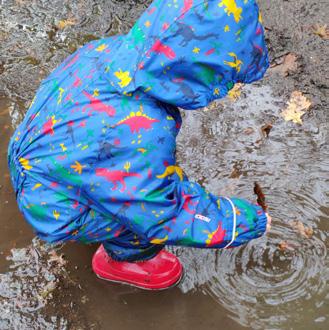
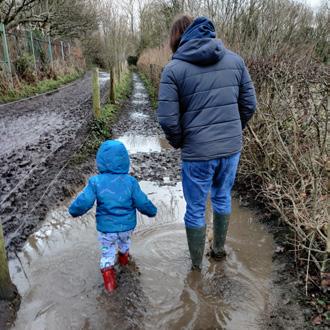
“Find a big puddle and explore moving the water by digging!”
Make a rain gauge: Using a clear container such as an empty large water bottle, carefully cut off the top and place it outdoors on a rainy day. Measure how much rainfall you collect!
Splash in puddles: Put on a pair of wellies and waterproof outer clothing and find the biggest puddles to enjoy!
Build a dam or tidal pool: Find a big puddle and explore moving the water by digging! Use stones or sticks to stop and manipulate the flow of water.
Solar power is generated by sunlight on solar panels. Many homes across the UK have installed solar panels to reduce their energy bills.
Shadow play: On a sunny day make chalk outlines of your shadows and then return to the same spot at a different time of day. Make observations, has the shadow moved?
Make a sun catcher: Collect natural found objects such as leaves and stick with PVA glue onto clear plastic (from reused packaging). Hang by a window for the sunlight to shine through.
Ice play: Set up ice water play on a sunny warm day and observe how long it takes for the ice to melt.
Taking the time on World Earth Day to think about our planet and the ways in which we can make an impact on a larger scale may seem incredibly daunting. However, as a parent myself, I believe that there will be big leaps in the future and renewable energy certainly seems a good place to start.
Dr Jane Goodall, after all her years of working alongside the natural world still brings a message of positivity, so I shall leave us with her words of wisdom: “I hope people realise that their actions, however small they may seem, will truly make a difference. The cumulative effect of thousands of ethical actions can help save and improve our world.”[3]


Julia Packwood has over 15 years of primary school teaching experience and is a qualified Level 3 Forest School leader. She is the founder of Nurturing Wild Ltd, an early-years outdoor education provider and consultancy. Learn more at: nurturingwild.com
1. teachearlyyears.com/ enabling-environments/ view/why-we-must-teachchildren-the-wonders-of-ourworld#:~:text=The%20end%20 of%20the%20film,don’t%20 protect%20it%2C%20who
2. nationalgrid.com/stories/ energy-explained/what-aredifferent-types-renewable-energy
3. Goodall, J. (2021) The Book of Hope. London: Penguin Books.
Author and mother, M. G. Leonard, explains her fascinating journey from loathing all things creepy crawly to loving our six-legged friends and sharing her passion with the world.
grew up hating every type of creepy-crawly, even butterflies. I had read so many books where insects were employed as a horror trope to suggest something or someone terrible was coming, that I would scream and cry if a bug buzzed near me. This continued until I became a parent, at 30. One day, my toddler son freaked out as a housefly zoomed around the room. I realised I had given him my fear and I felt ashamed.
In a bid to fix this, I started learning about bugs. I picked the beetle to start with because I found them less frightening than other critters. I was immediately shocked by the depth of my ignorance about this wonderful little creature. When I thought of a beetle, I thought of a ground beetle. I didn’t know that beetles had wings. I didn’t know the ladybird was a beetle. I didn’t know that fireflies were beetles. I didn’t know there are over 400,000 known species of beetle on earth. And so began my journey into the wonderful world of Coleoptera (the scientific name for beetle).
“I understand people who are frightened of bugs. I was one”
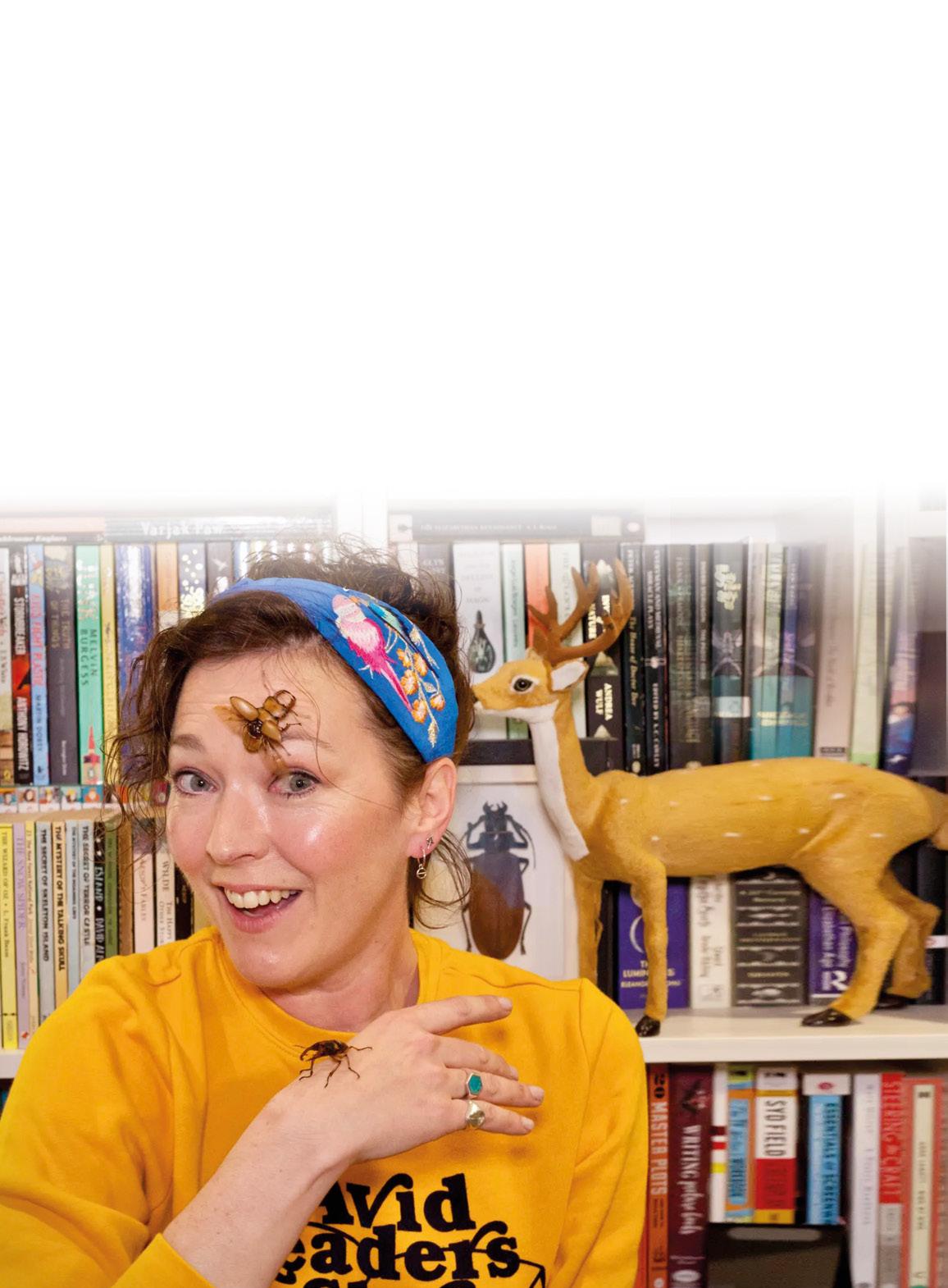
I searched for books to read to my son with positive stories about insects. Once a child is beyond picture book age there is very little. I couldn’t find any chapter books about beetles. That’s when I decided to write Beetle Boy.
I spent six years researching, talking to entomologists, visiting insect museums and attractions and going on bug hunts before I knew enough to write an adventure story in which beetles were adorable heroes. I found it a challenge to write about insects without the oft-repeated, horror-laced, adjectives creeping into my prose. However, I had become zealous about my cause and persevered. After a decade of work, I had a book that a publisher wanted. It went on to be a global bestseller and I am known by children as ‘the beetle lady.’
“Children deserve to know how marvellous insects are”
Children deserve to know how marvellous insects are. Many of them will never see an elephant or a lion in the wild, but every child can see insects in their natural habitat, even if they don’t have a garden. These creatures are the most immediate link to the natural world we have and yet we vilify them and kill them with pesticides. I understand people who are frightened of bugs. I was one. But if we all knew more about insects that fear would change to fascination. I know this to be true from personal experience.


Beetles are the single most important creature on the planet for the health of the environment. They break down dead wood, dung and animal corpses, as well as pollinating plants and being an abundant food source for birds, small mammals, and in some countries, humans. If you like birds, then you must like bugs because 90% of birds eat insects. No bugs. No birds. Simple. And there is a lot to like about the humble beetle. Species come in every colour imaginable, even gold. Some are so beautiful they are called jewel beetles and used as accessories. They come in all shapes and sizes from the microscopic to the massive. Some even have superherolike skills.
Did you know a rhinoceros beetle can lift 850 times its own body weight? Or that bombardier beetles shoot hot acid out of their abdomens at predators? Or that a Tiger beetle runs so fast it can’t see? I find beetles endlessly inspiring. I’ve written five books about the insect. My newest adventure, Hunt for the Golden
Scarab is inspired by Ancient Egypt where the dung beetle was sacred and revered as a sun god. They were a symbol of life and regeneration. When a person died, a scarab was carved from stone, a spell from the Book of the Dead was inscribed on it, and it was bound over the heart with mummification bandages to keep the deceased’s secrets as they were tested in their journey through the underworld.
Beetles have changed my life, my mind, and my heart. I have kept them as pets for a decade and take them into schools to meet curious children. If you would like your children to see the wonder of insects, there are lots of fun activities you can do with them in spring or summer. You could get involved in The Great British Stag Hunt and help monitor an important and declining species of British
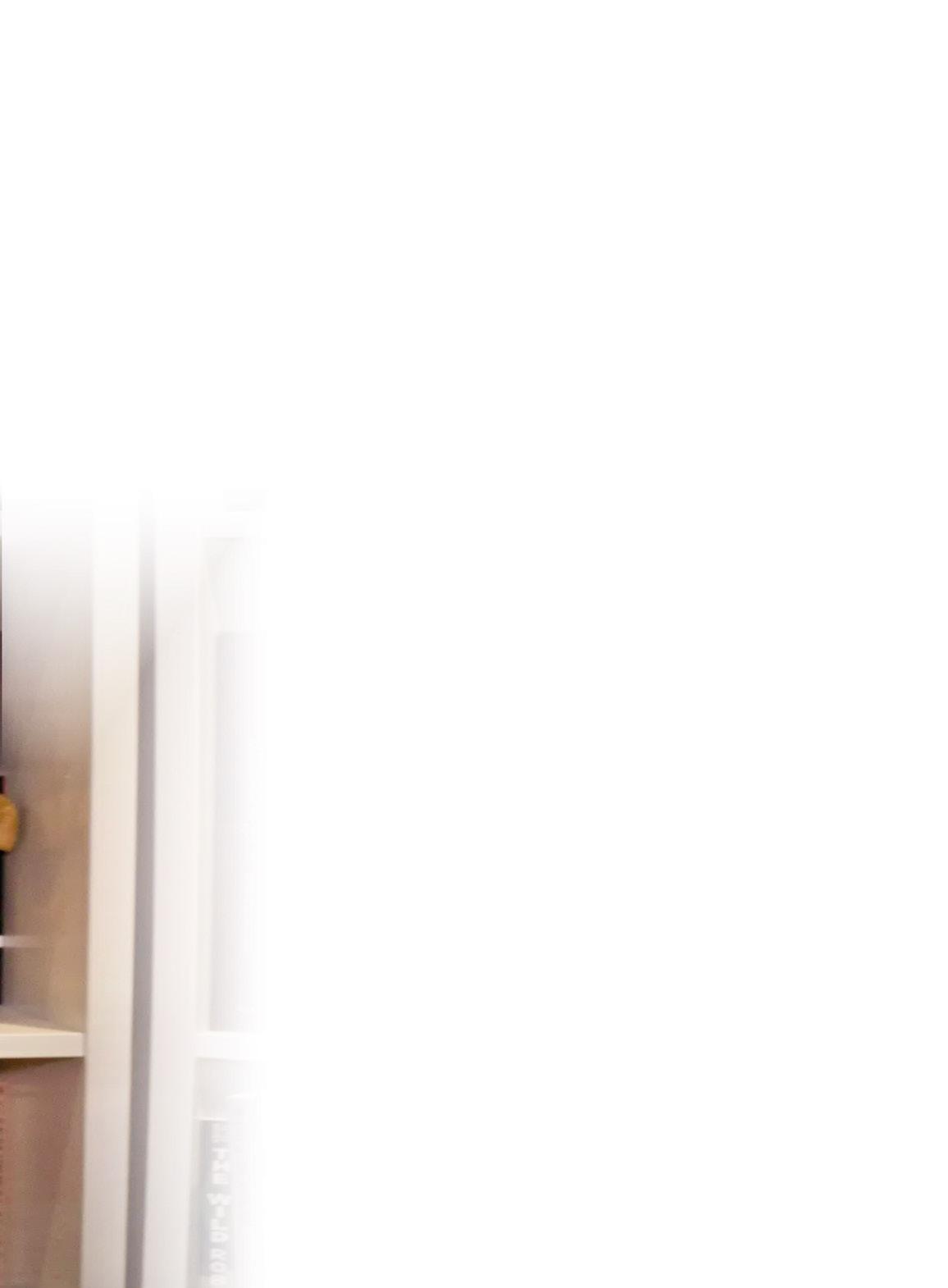

beetle. How about building a bug hotel in your garden, to encourage insect life? Grab a sweeping net and a field guide and go on a bug hunt. Once you open your mind to beetles, you’ll be surprised how many species you see. Or, if you want an adventure to read at bedtime, why not pick up one of my books.
M.G Leonard’s novel Hunt for the Golden Scarab is published in Paperback on 30th January. Available from all good bookshops at £7.99 – get it while stocks last. tinyurl.com/mvcxcry3

Nature is all around us and what better way for kids to gain an appreciation of the world around us than to capture it on camera. The winners of the Young Wildlife Photographer of the Year competition showcase the beauty of plants, birds and animals from around the world.
The winners of the 2024 Young Wildlife Photographer of the Year competition, run by the Natural History Museum, have been announced. Running alongside the adult competition, Young Wildlife Photographer of the Year showcases images from talented young photographers from around the world.
“A photographer attempting to capture this moment not only brings great skill, but incredible attention to detail, patience and perseverance”
Alexis Tinker-Tsavalas from Germany was awarded first prize as Young Wildlife Photographer of the Year 2024 for his up-close image ‘Life Under Dead Wood’, depicting the fruiting bodies of slime mould on the right and a tiny springtail on the left.
Alexis quickly rolled over a log to take the intriguing image, moving fast as springtails can jump many times their body length in a split second. Alexis used a technique called focus stacking, where 36 images, each with a different area in focus, are combined.
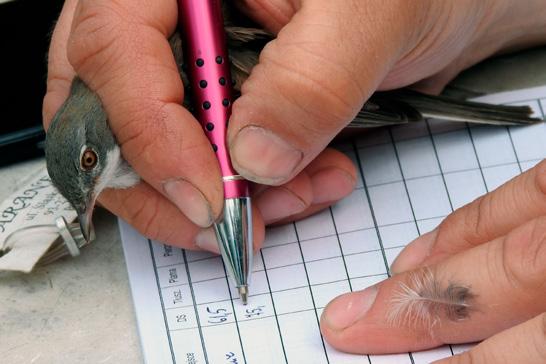



Springtails are found in almost every corner of the globe as one of the most abundant of all macroscopic animals. They are vital for improving soil health by feeding on microorganisms such as bacteria and fungi, helping organic matter to decompose.
“A photographer attempting to capture this moment not only brings great skill, but incredible attention to detail, patience and perseverance. To see a macro image of two species photographed on the forest floor, with such skill, is exceptional,” said judge Kathy Moran.
Winning the 10 years and under category, ‘Free as a Bird’ by Alberto Román Gómez from Spain, shows a delicate stonechat bird next to a heavy metal chain. Watching from the window of his father’s car at the edge of the Sierra de Grazalema Natural Park, Alberto found this young bird tricky to photograph as it was quickly flying back and forth, gathering insects. This young bird has not yet developed its adult call, which sounds like two stones tapped together. Stonechats tend to prefer open habitats and typically perch on fences.
Taking first place in the 11-14 years category was a raw photograph of a young Cooper’s hawk eating a squirrel. Photographer Parham Pourahmad from the USA captured the bird enjoying a “meal” at Ed R Levin County Park in California. Over a single summer, Parham visited Ed R Levin County Park most weekends to take photographs. He wanted to showcase the variety of wildlife living within a busy metropolitan

“Nature will always be wild and unpredictable”
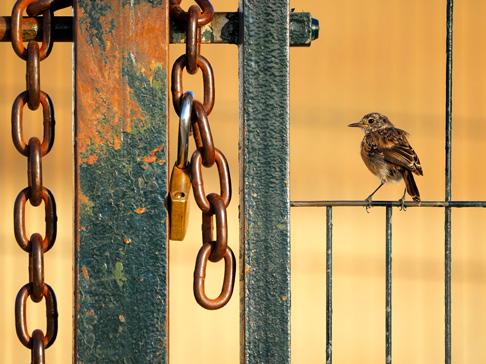
city and to illustrate that “nature will always be wild and unpredictable.” The Cooper’s hawk is a common species across southern Canada, the USA and central Mexico, where it inhabits mature and open woodlands. These adaptable birds also live in urban spaces, where there are tall trees to nest in and bird feeders that attract smaller birds, which they can prey on.
To celebrate the sixtieth anniversary of Wildlife Photographer of the Year and in line with the Natural History Museum’s vision of a future where both people and planet thrive, the competition introduced the Impact Award for both the Adult and Young Photographer categories. This award recognises a conservation success; a story of hope and/or positive change.
The Young Impact Award was given to Liwia Pawłowska from Poland, who entered the competition’s Young Wildlife Photographer of the Year category with her image ‘Recording by Hand’. This photograph spotlights a relaxed common whitethroat as part of bird ringing, a
technique that aids conservation efforts by recording a bird’s length, sex, condition and age to help scientists monitor populations and track migratory patterns.
Liwia is fascinated by bird ringing and has been photographing ringing sessions since she was nine. She said that she hopes her photograph “helps others to get to know this topic better.”
Dr Doug Gurr, director of the Natural History Museum, said: “Wildlife Photographer of the Year’s longevity is a testament to the vital importance and growing appreciation of our natural world. We are delighted to feature such inspiring images in this year’s portfolio – these are photographs that not only encourage further wildlife conservation efforts, but that spark the creation of real advocates for our planet on a global scale.”
Celebrating its sixtieth year, the Wildlife Photographer of the Year exhibition featuring all of the awarded images runs until Sunday 29th June 2025 at the Natural History Museum, London. For more information, visit: nhm.ac.uk
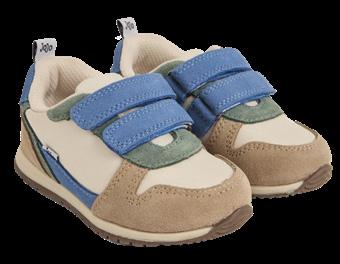




As temperatures tease us with the promise of warmer weather, we can finally look forward to walks in the sunshine, plentiful picnics and outdoor escapades, says deputy editor Becky Todd. With the unpredictability of British weather remaining reassuringly familiar, we’ve got the perfect pieces to layer to make sure your little ones are ready for anything.




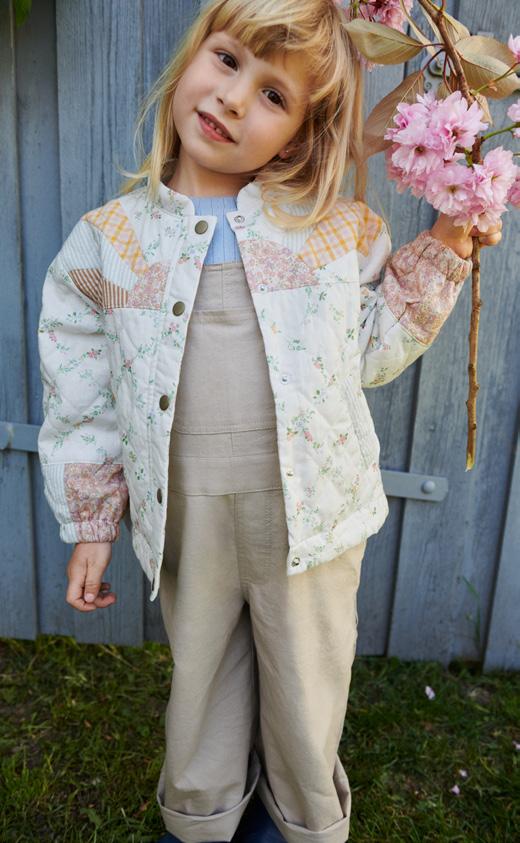



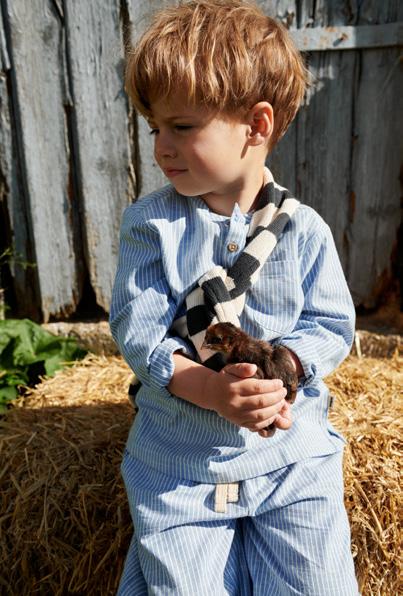
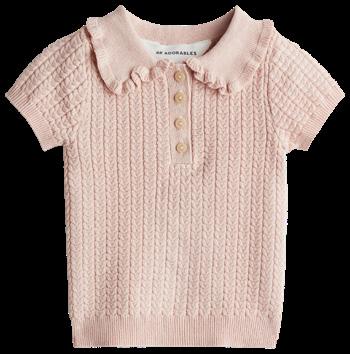




Enjoy 15% off full price clothing at Trotters with code FAMILYFIRST15. Redeem instore and online (excluding Trotters concessions). Valid for one redemption only until the 19th June 2025.




Jennifer Mazur, a pregnancy and postnatal yoga teacher and the founder of Mums’ Yoga Club looks at how yoga can support us in early motherhood – both on and off the mat.
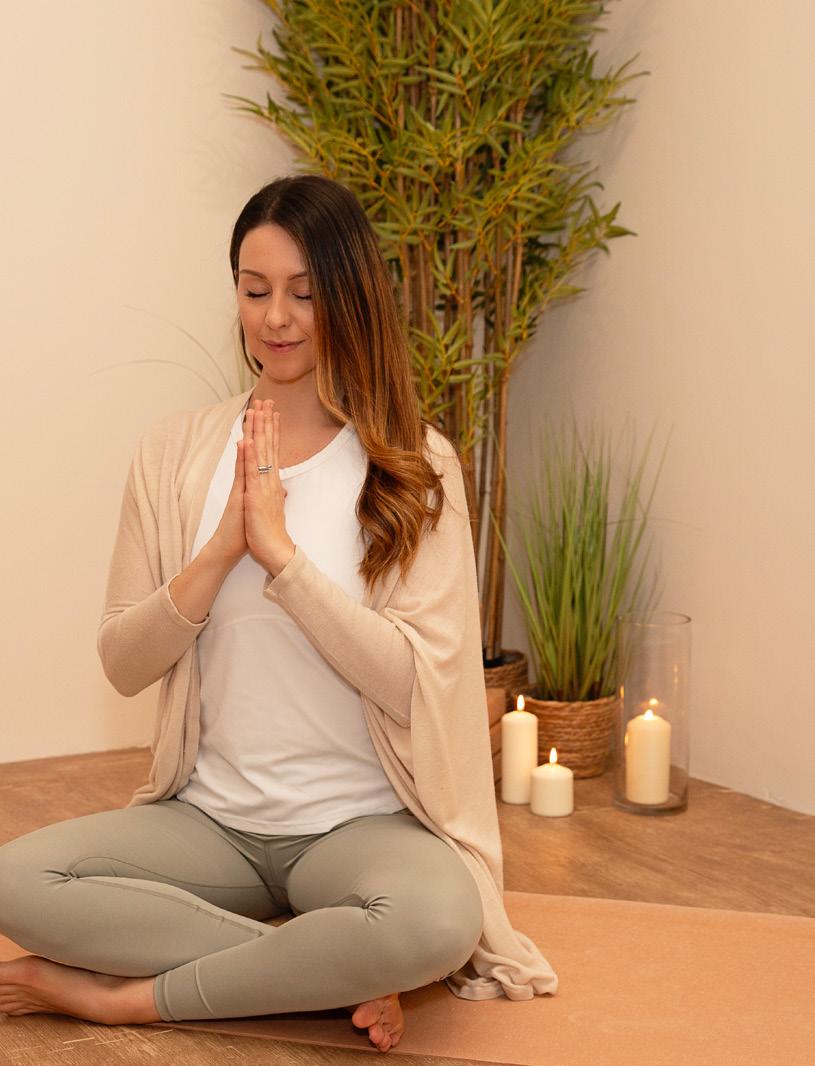

Motherhood in the early years is a beautiful, exhausting, all-consuming season. One minute, you’re soaking in baby snuggles, the next, you’re trying to drink cold tea while managing a full-blown toddler tantrum. Your body aches, your mind is racing and finding time for yourself? Ha! But that’s exactly why yoga can be a game-changer in early motherhood.
“You don’t need an hour or a perfectly serene space – just a few minutes here and there can make a huge difference”
Yoga isn’t just about stretching or bending into fancy poses – it’s about supporting you in a way that meets you exactly where you are. It can ease the aches and pains of carrying little ones around all day, whether that’s tight shoulders from endless feeding sessions or lower back tension from bending down a hundred times an hour. It also helps rebuild strength in the body, especially in your core and pelvic floor, giving you more energy to handle the physical demands of motherhood. And despite what you may think, you don’t need an hour or a perfectly serene space – just a few minutes here and there can make a huge difference.
But the benefits of yoga go way beyond how we feel physically. In early motherhood, your nervous system can take a hit, constantly running on overdrive, which can lead us to functioning in this low-level stress state more often than not. Yoga gives you the tools to find

moments of calm, even in the middle of the chaos. A few deep breaths can shift you from feeling overwhelmed to feeling more grounded and some mindful movement can help you release stress rather than carrying it around all day. And when you practice yoga – even just for five minutes – you’re signalling to your brain that you matter too, because you absolutely do!
It’s easy to lose your sense of self in these early years, pouring every ounce of energy into your little one and learning the role of ‘mum’. But when you roll out your mat (or even just take a few deep breaths), you create space to check in: how am I feeling? What do I need? Reminding you that your wellbeing is just as important as anyone else’s. And when you feel more centered, it spills over into how you show up for your family – with more patience, more presence and more joy.
The beauty of yoga is that it doesn’t have to be a solo practice. Your baby or kids can be part of it too, whether they’re snoozing beside you, wriggling around on the mat, or even joining in with playful stretches. It’s a way to bond, move and create moments of connection, all while giving yourself the support you need. And if the thought of squeezing in a structured class feels impossible, remember that yoga is flexible (literally and figuratively). It can be as simple as stretching while your little one plays, taking deep breaths while rocking them to sleep, or rolling your shoulders while waiting for the kettle to boil (hoping you’ll get to drink it warm this time!).
If you like the idea of yoga but aren’t sure where to start, I’ve got you covered. Mums’ Yoga Club: The Online Membership is designed for mums like you. It is realistic, accessible and made to fit into your life, not the other way around. Whether you want to move solo or include your little one, there’s something for you.
Right now, you can get 20% off an annual or monthly subscription by using the code FAMILYFIRST20. Because I know how hard it can be to put yourself first, but I also know how much better everything feels when you do.
“Yoga gives you the tools to find moments of calm, even in the middle of the chaos”

There’s also something incredibly powerful about being part of a community of mums who just get it. Knowing you’re not alone, that others are navigating the same highs and lows, can be so reassuring. That’s why having a space to practice together, share experiences and feel supported is just as important as the yoga itself. It’s not just about movement – it’s about connection, both to yourself and to a like-minded group of mums who are prioritising their wellbeing too. This isn’t about being perfect or adding another thing to your plate, it’s about giving yourself a moment to breathe, move and feel good in your body again. Because when you take care of yourself, you show up for your family in the best way possible. If you’re curious, I’d love for you to join me. Let’s make yoga a simple, enjoyable part of your motherhood.


Jennifer Mazur is a pregnancy and postnatal yoga teacher and the founder of Mums’ Yoga Club, an online yoga platform dedicated to helping mums build calm and strength through every stage of motherhood. Passionate about making yoga accessible and realistic for busy mums, she believes that even the smallest moments of movement and breathwork can have a profound impact.


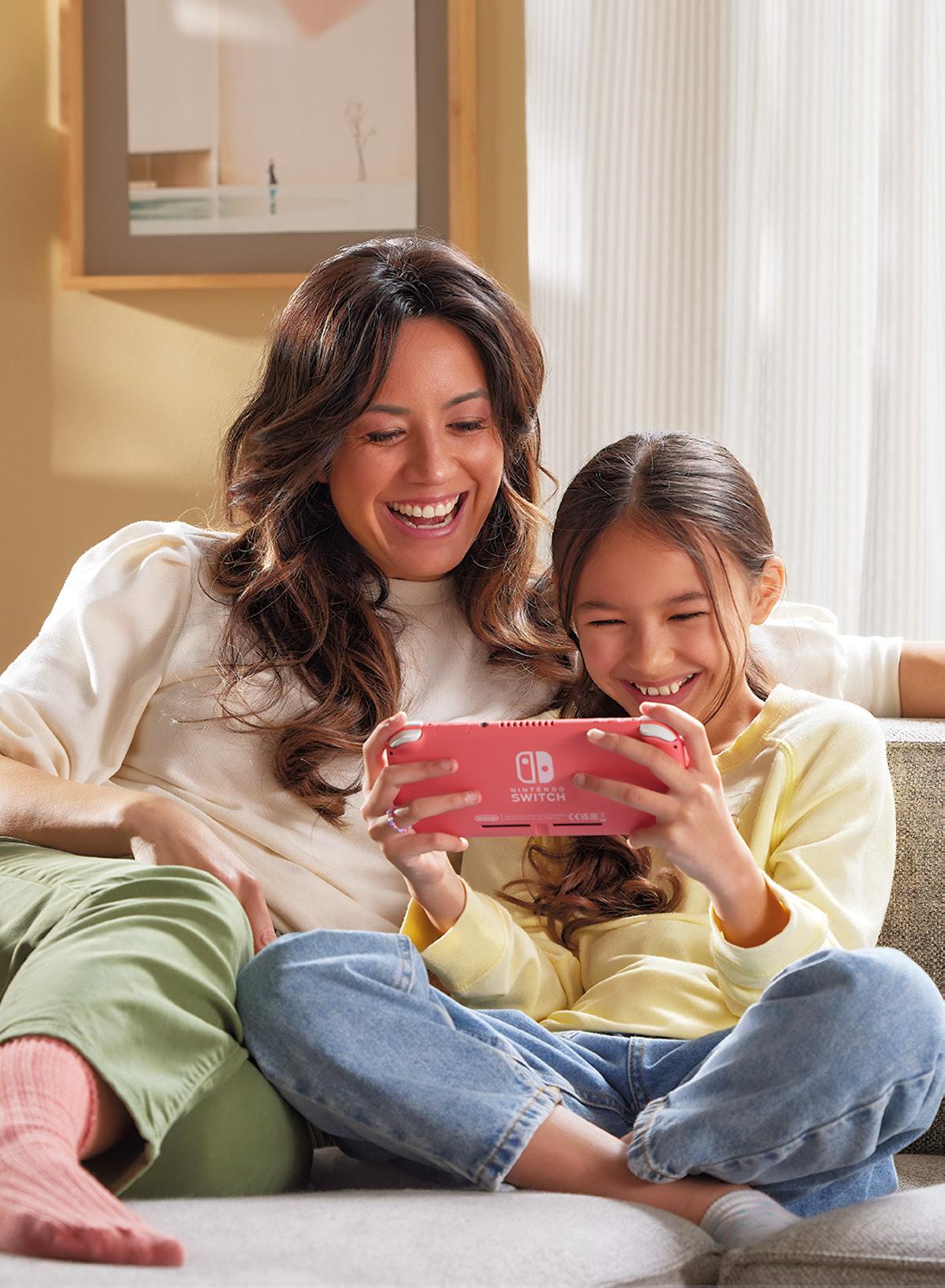

As a parent, it’s not always easy to keep an eye on your children’s time spent with entertainment devices. The Nintendo Switch Parental Controls smart device app is a free smart device app which you can link with Nintendo Switch to easily monitor what and how your children are playing.
There’s even a function in the Nintendo Switch Parental Controls smart device app where you can see a report of which video games your child has been playing, and for how long.
In the Nintendo Switch Parental Controls smart device app, you can set a time limit for how long your child is allowed to play. When it’s time, an alarm will be triggered on Nintendo Switch to let them know their play time is up.


• Prevent children from playing games that are inappropriate for their age
• Restrict communication with other users
• Restrict the ability of posting screenshots to social network services

Table Tennis England explains how easy it is to grab a bat and ball and start playing table tennis, plus looks at the mental and physical benefits for the whole family.
Table tennis is one of the most accessible, sociable and enjoyable sports in the world. It is a hit with children of all ages and abilities and can do wonders for fitness, social skills and self-esteem. Whether a beginner who wants to play for fun, an improving player keen to start competing or a fan inspired by some of the world’s top players, there is an opportunity waiting for everyone.
Table tennis is great for health and as little as 10 minutes of play at a time can improve fitness and energy levels. It’s a non-contact sport and can be played at
all levels to meet an individual’s capabilities, making it fun for young and old alike – a truly inclusive sport. The whole family can play together and it is even wheelchair friendly. Table tennis is great for mental health as

“Playing regularly has been shown to reduce stress and anxiety and improve self-esteem”


Oh, and the rules are really easy to learn too – in short, what’s not to like?
Getting into table tennis and picking up the basic skills couldn’t be easier. There are so many places you can play, including clubs, schools, parks, shopping centres and many other public locations that have free-to-play tables. Visiting Table Tennis England’s Table Finder (tabletennisengland.co.uk/table-finder help you locate somewhere near you.
You can also play at home – a dining table can easily be converted into your very own playing arena by using a roll-net or even a row of books or tins. Many sports stores stock essential playing equipment such as bats, balls and nets at affordable prices, and specialist table tennis retailers can be found online.
You can find the basic rules online by visiting the Table Tennis England website (tabletennisengland.co.uk/rules-and-howto-play). What are you waiting for? Just get on the table and join the hundreds of thousands of people who regularly play table tennis in England.
For players wanting to improve their game, joining a club and getting some tips from a coach can be a great next step.
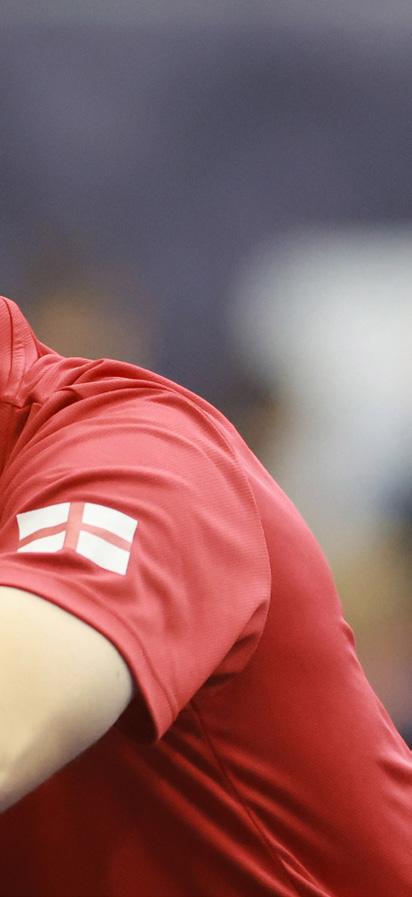
“A dining table can easily be converted into your very own playing arena”
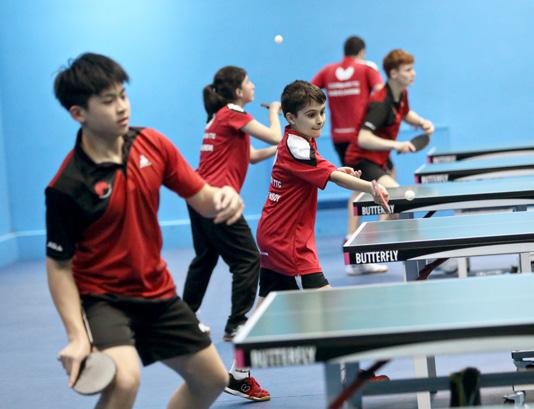




As well as teaching more advanced playing skills, clubs can help you to try out different types of equipment, helping to discover the perfect bat and rubber combination.
As you improve, you might want to enter competitions – wherever you are in the country, you’ll find local leagues and oneoff competitions, and there are national competitions if you really want to test yourself. Maybe one day you can appear in the national rankings list or even play for England – there’s no limit to where table tennis can take you.
As well as playing, you can be inspired by watching some of the best table tennis players in the world on your doorstep. London has two massive events coming up: the WTT Star Contender in October 2025 will feature superstar players from all over the world. The top teams will then compete for glory at the World Team Championships in May 2026. Check online to find out how you can get tickets and see the modern legends of the game as part of a passionate crowd of thousands of fellow fans.
Still not convinced? Perhaps England’s No. 1 player Liam Pitchford can persuade you: “I started playing at primary school with my friends one day when it was too wet to go outside. There was a lunchtime table tennis club, so we went along and straight away I loved the speed, skill, spin and everything else about the sport.

“I joined a local club and the coaches there helped me to improve my game. With a lot of practice, I became good enough to play in competitions and soon I was playing for England juniors. When I was 19, I played for Great Britain at the London 2012 Olympic
Games – now I’ve played at the Olympics FOUR times and it feels amazing to represent my country.
“I’ve been lucky enough to travel the world playing table tennis. I’ve made lots of friends – and I’ve won quite a few medals too! But the most important thing is I’ve always loved playing.
“To anyone who is thinking of playing table tennis, you should definitely give it a go. I promise you’ll love it like it did – and maybe one day you could play for Great Britain like me!”

Table Tennis England is the National Governing Body for table tennis, responsible for everything from the grassroots all the way up to the England teams. The Table Tennis United strategy aims to turn England into a ‘Table Tennis Nation’ by delivering success on the Olympic stage, strengthening clubs and leagues, increasing participation and creating a world-class coaching and officiating workforce. Table Tennis England has free membership for under-11s and supporters, among other membership options.
Visit tabletennisengland.co.uk to find out more about our work.
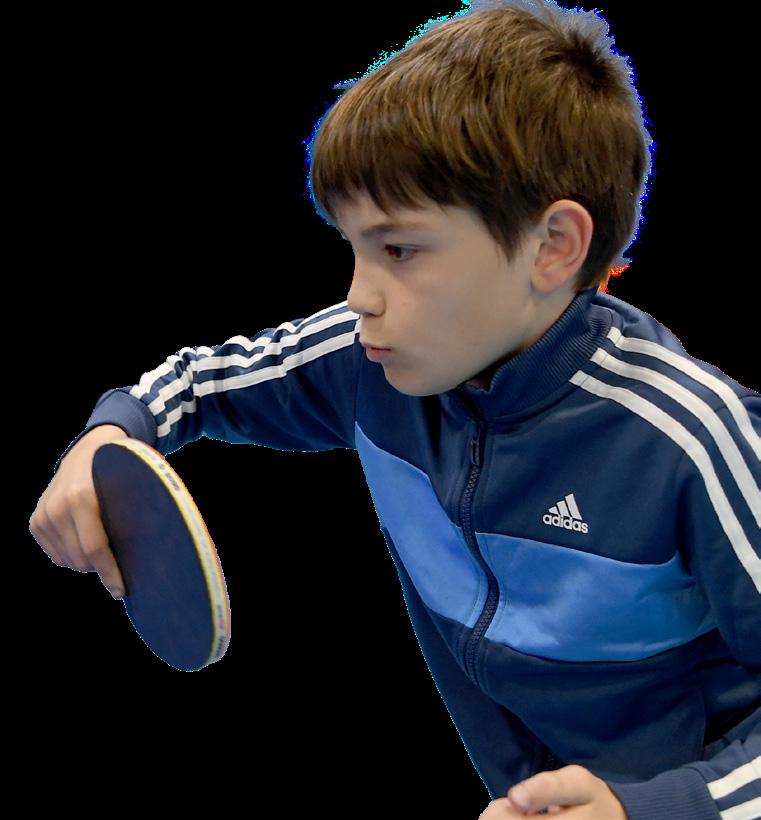
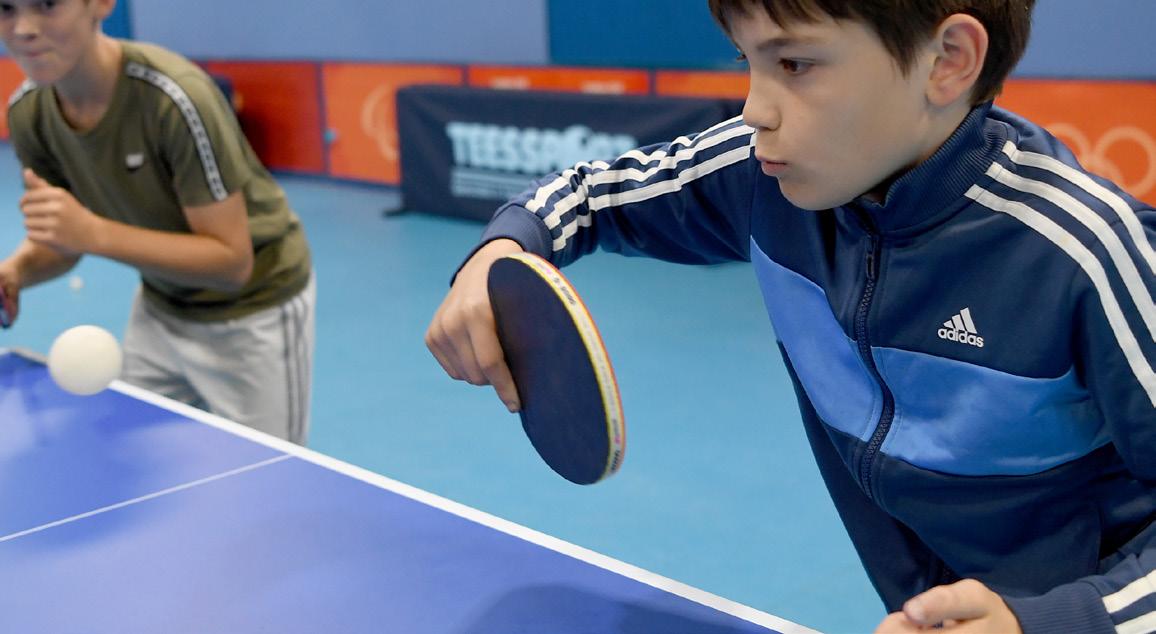








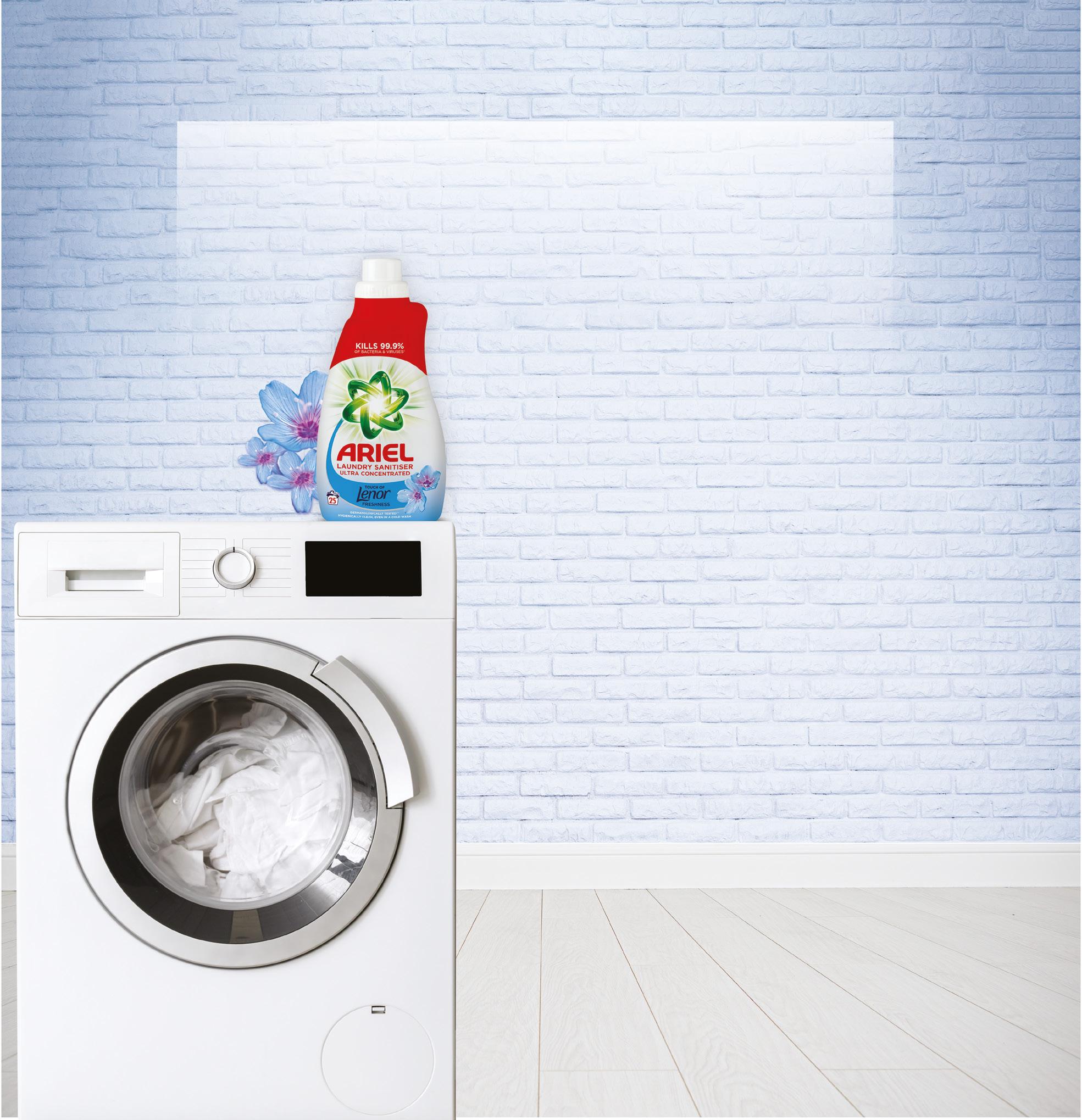
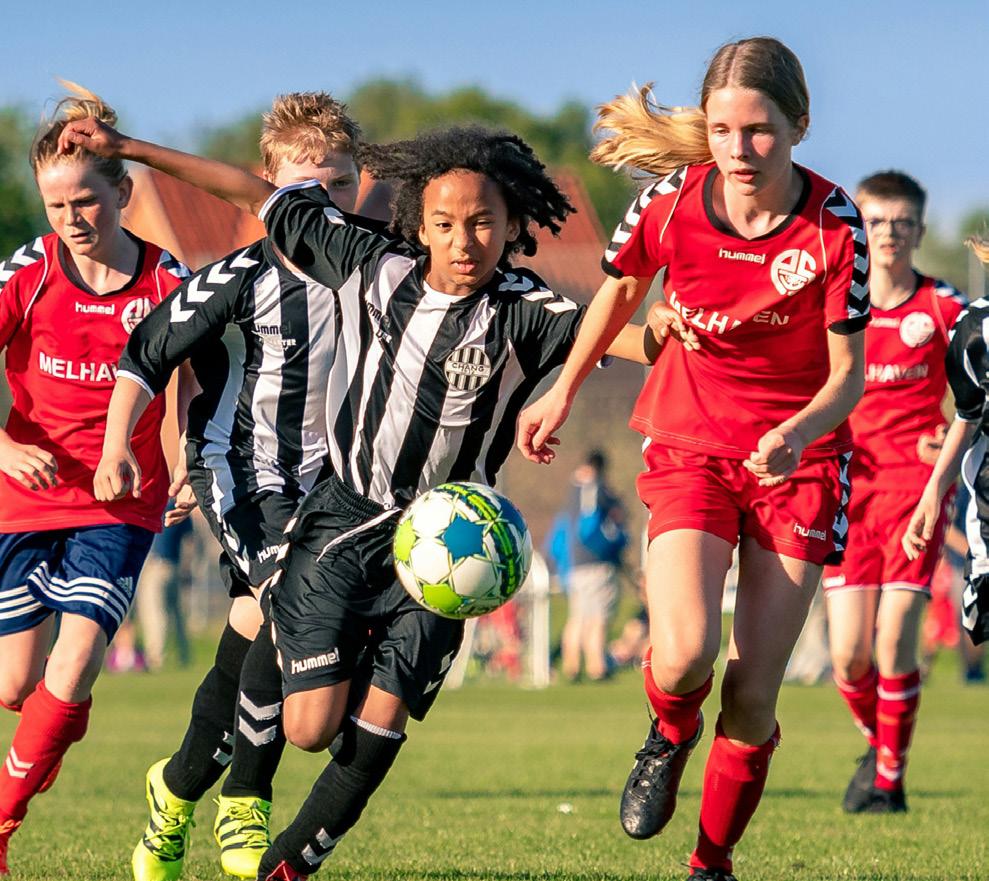
Sports writer, Caroline Kings speaks to footballer Lipa Nessa about her love of the sport, encouraging young women to play football and how her religion has impacted her sporting career.



Lipa Nessa didn’t grow up wanting to be an activist, but thanks to her love of football, a desire to challenge the status quo and her faith, she is one now. The woman with ‘a hijab on her head and a ball at her feet’ is articulate, intelligent and fun to talk to and it’s easy to see how she came to work with big names such as the Youth Sport Trust, Sweaty Betty Foundation and HRH the Duke of Edinburgh on his award scheme.
Lipa’s love of football began in the years before she chose to wear a hijab. She grew up in Bedford, part of a workingclass family with two sisters. Sport was on TV often and being sat in front of the Olympics and football while her mum ironed are two standout memories for Lipa. It was children’s TV and some Tweenies’ merch that kicked off her love of football, though. “My parents bought me a Tweeniesthemed football and that’s what started me playing!” she says.
Looking back, Lipa acknowledges that she was an energetic and noisy child. “Football was a safe space and the right place for me to use that energy.”

the next day. “The best way to describe it is that football felt like flying. Wherever I scored, be it the back garden or school playground, it felt like a mini stadium to me. Without football, I’m sure I would have been in trouble more at school, but it calmed me down ready for lessons.”
Lipa’s school experience
Her passion for ‘the beautiful game’ continued into her super-sporty middle school. The school didn’t have a girls’ football team, but Lipa spoke up: “I said, ‘Sir, we need a girls’ football team,’ and he was all for it. He just said, ‘If there are enough girls we’ll make it happen,’ and it did!”
“Football was a safe space and the right place for me to use that energy”

Lipa was happiest with a ball at her feet, whether it was Eid celebrations, scoring goals with male cousins while receiving disapproving looks from family elders for being immodest or playing in the playground with the boys despite teachers refusing to give her the football and telling her she should play with a hula hoop instead. She brought in her own ball

At high school, boys and girls were separated for classes and Lipa didn’t feel as though she could play footy with the boys anymore. She still had lots of energy, but noticed that the girls became less active; even the sporty ones preferred to “sit around and gossip and then walk a bit.”
It was at high school that everything changed, though. Here there was a girls’ football team and a very attentive PE department. While Lipa and the girls’ football team were winning trophies and climbing up the county rankings, her PE teachers were starting to notice her skills. “It was during a PE lesson that the teachers gathered together and called me over. I was worried I was in trouble, but instead, they asked me which club I played for and where I had learnt to play football so well. I answered that I just played in my back garden and they said ‘Wow, you need to find a team straightaway!’”
And so, she did and aged 15, Lipa signed a semi-professional contract and her career in sport began.
In the Islamic faith, girls don’t need to wear a headscarf (which is a part of the hijab) until puberty and when Lipa hit that stage, her parents allowed her to educate herself and make her own decisions. Lipa refers to ‘finding religion’ and that’s when she chose to wear the headscarf. She explains, “The headscarf isn’t looked upon favourably by non-Muslims, but for us, it’s a sign of empowerment and modesty and comfort. It shows that we’re Muslims just like a Christian might wear a cross.”
It was 2007 and FIFA had just banned the wearing of religious headscarves for female footballers. It was headline news and at the same time, by coincidence, Lipa started to wear one. “The coach and I had always got along well. We’d been the best of friends; he’d made me want to come to training; he made it feel like home. But then one day, there was a corner in the game. I ran and jumped and headed the ball inside the goal. My headscarf slipped a little and the coach said, ‘That’s why you shouldn’t wear that stupid thing on your head.’ I felt so small and all of a sudden, football felt foreign to me.”
Lipa changed clubs and had a better
experience there, but it is comments like those of her coach that have informed her activism. After visiting a school in Bethnal Green where girls were not allowed to wear a headscarf for PE and a chance conversation with the head of the Sweaty Betty Foundation, she helped design a sports hijab for the high street brand, alongside other Muslim women and girls. Three hundred are donated every year and money raised from the sale of this essential piece of kit goes back to the Foundation, which ultimately helps all girls.
Day to day, Lipa helps coach children’s football and assists with funding proposals. She speaks to minority communities to give them a voice at every level, as well as appearing on TV and radio, but no two days are the same. In October 2024, she was the first recipient of the ‘Activist of the Year’ award at the Girls Human Rights Awards, an international platform, and she was nominated in the Muslim Excellency Awards.


“My parents bought me a Tweeniesthemed football and that’s what started me playing!”
What does being an activist mean to her? “To defy norms and values, to go against the grain; to check and challenge those in power and to be the voice of many. To be comfortable feeling uncomfortable and to be unapologetically myself. I want all girls to be able to participate in sport without compromising their norms and values but also allowing them to disrupt! I want them to feel as though they too can be unapologetically themselves.”
For more on the Sweaty Betty Foundation, visit: sweatybettyfoundation.org
Caroline Kings is a writer and the co-founder of We Are Girls in Sport (wearegirlsinsport.com), which aims to help girls find a sport they love and stick at it.
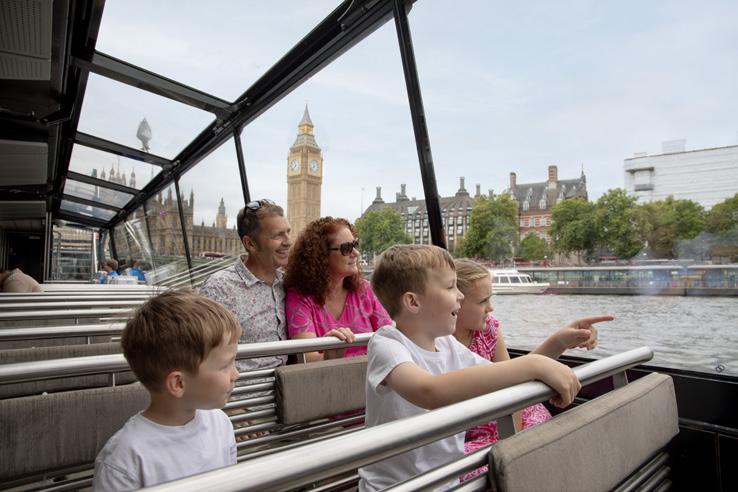














Look out tennis, badminton and squash…there’s a new ball game in town. It’s called Pickleball and, guess what, it has nothing to do with pickles! Karen Mitchell, Chair and Co-Founding Director of Pickleball England, talks us through the basics and how you can get involved.
With an estimated 40,000 people now playing across the country, Pickleball England is on a mission to get more people involved in this family-friendly sport.
The game is played on a badminton-sized court with rectangular paddles and a wiffle ball (a plastic ball with holes in). It can be played as a singles game (with two players) or a doubles game (with four players). To begin, you serve the ball diagonally across the court and then volley and rally until someone scores a winning shot. The first to 11 points wins, but you must win by 2 points (e.g. 11-9).
It’s accessible to all skill levels, with simple rules that can be adapted for beginners. What’s more, it builds hand-eye co-ordination, agility and is really sociable. Once you play a couple of times, you’ll have the game down and you’ll want to play again and again. Before you know it, you’ll have seasoned pickleball players in your family.
The game was first invented in 1965 by three men in the United States to keep their children entertained during the summer. Since then, it has become one of the fastest-growing sports in America and is now making waves this side of the Atlantic too. It’s a game that can be played by young, old, and everyone in between and that’s what makes it so inclusive. The whole family can play together!
Physical activity: Pickleball is a cardio workout that’s good for your heart, lungs and muscles.
Hand-eye coordination: Children improve their hand-eye coordination as they predict the ball’s flight and position themselves.
Agility and dexterity: Children refine their agility and dexterity as they move quickly to volley the ball.
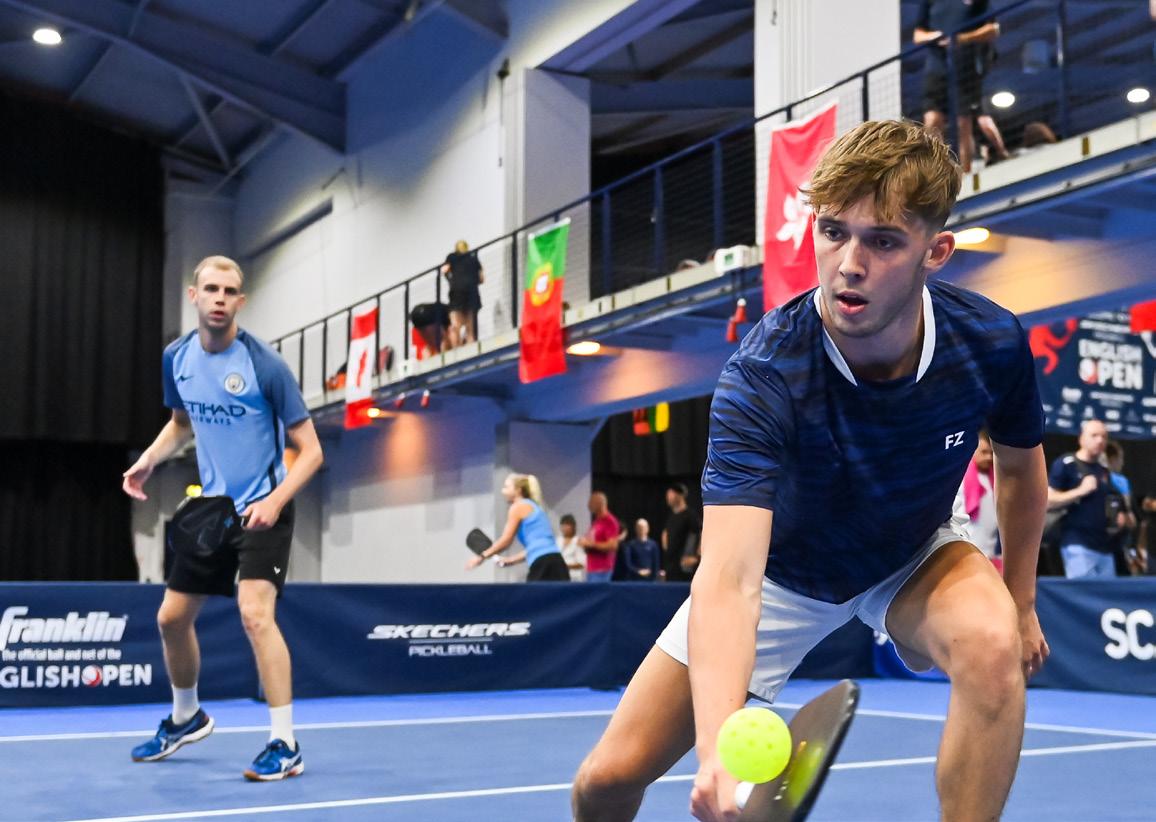
“It’s a game that can be played by young, old, and everyone in between and that’s what makes it so inclusive”
Social skills: Pickleball encourages communication and teamwork, and it can help children feel a sense of belonging.
Mental stimulation: Pickleball encourages strategy and can help with mood stabilisation.
If it hasn’t already, it may show up in your children’s PE lessons very soon. Pickleball England is working with schools up and down the country to include pickleball in PE lessons and after school clubs.
Need a little help from some experts? Professional Pickleball coach Sam Basford (who was part of the team that coached Team England to victory in last year’s European Championships) and British number 1 female singles player Mollie Knaggs, have some top tips for children and adults alike:
“Pickleball is an accessible sport with a low barrier to entry and a low cost to play”
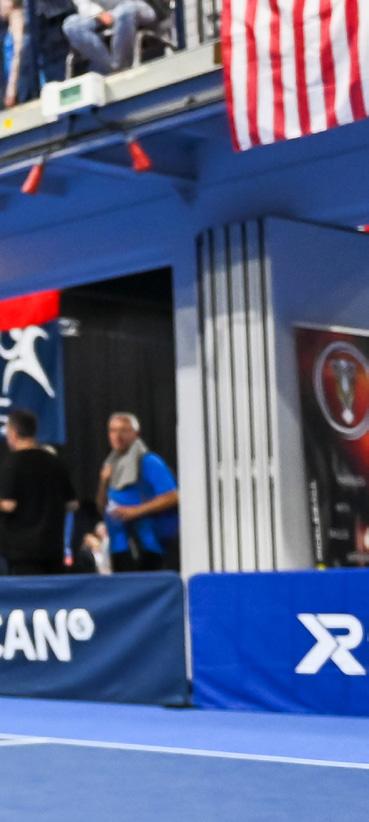
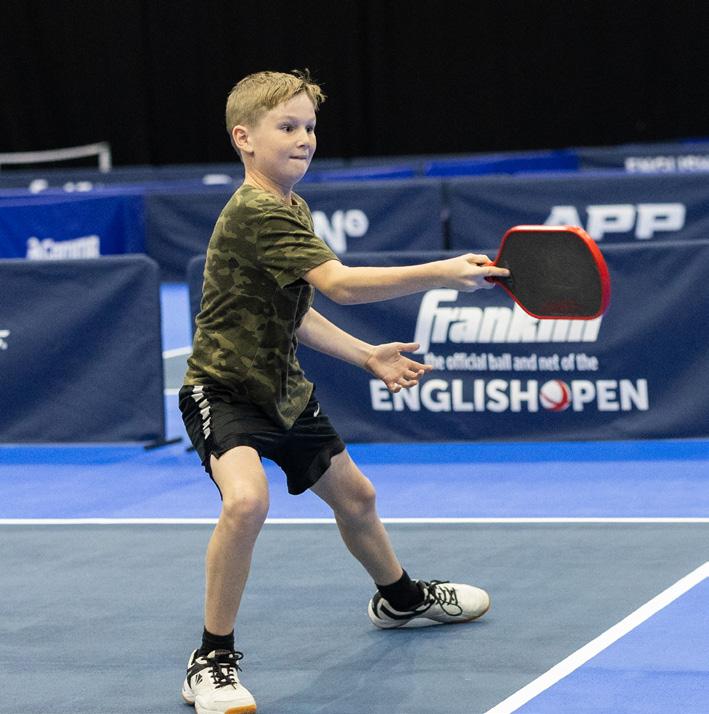
“If you’re new to pickleball, I’d definitely encourage you to just get on the court and give the ball a hit to get used to the feel of it. Once you’ve hit for a few minutes, see if you can stand near the box at the front of the court and use the other side as a target to rally into. This is great for building up your hand-eye co-ordination and ball control. Most of all, I’d say just enjoy it - pickleball is such a sociable sport and part of the fun is playing with your family and friends with a smile on your face!”Sam Basford, Professional Pickleball Coach
“Pickleball is one of the most inclusive sports in the world and it can empower people of all ages because you can have fun and compete, even when you’re just starting out. It’s especially good for women and girls to play, because I’ve seen it boost their self-esteem and confidence both on and off the court. It’s a sport families can play and enjoy together straight
away - my younger sister has never played sport and she came along to play with me and within 10 minutes we were playing a game. I’d really encourage anyone to pick up a paddle and get on court!” - Mollie Knaggs, British no.1 Female Singles Player
Pickleball is an accessible sport with a low barrier to entry and a low cost to play. All you need is a paddle and a wiffle ball and you’re good to go. Websites such as The Pickleball Store (thepickleballstore.co.uk) offer beginner starter sets for schools or familyfriendly games.

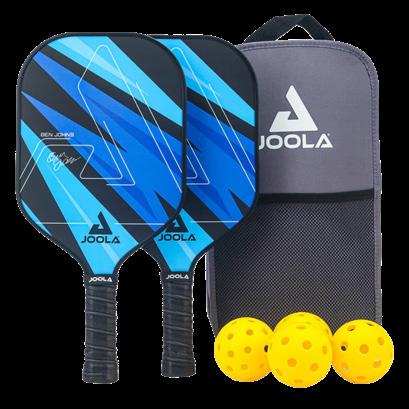

Pickleball can be played indoors and outdoors, with courts available in leisure centres and clubs all over the country. To find your nearest place to play, head to the Pickleball England website ( pickleballengland.org) and click the ‘Club Locator’. Once there, type in your postcode and find your nearest club or venue to get started.
Pickleball England is a non-profit organisation set up to promote and encourage local, national and international level pickleball. Pickleball England also acts as the sole governing or delegating body for the sport in England. More information about Pickleball can be found by visiting pickleballengland.org

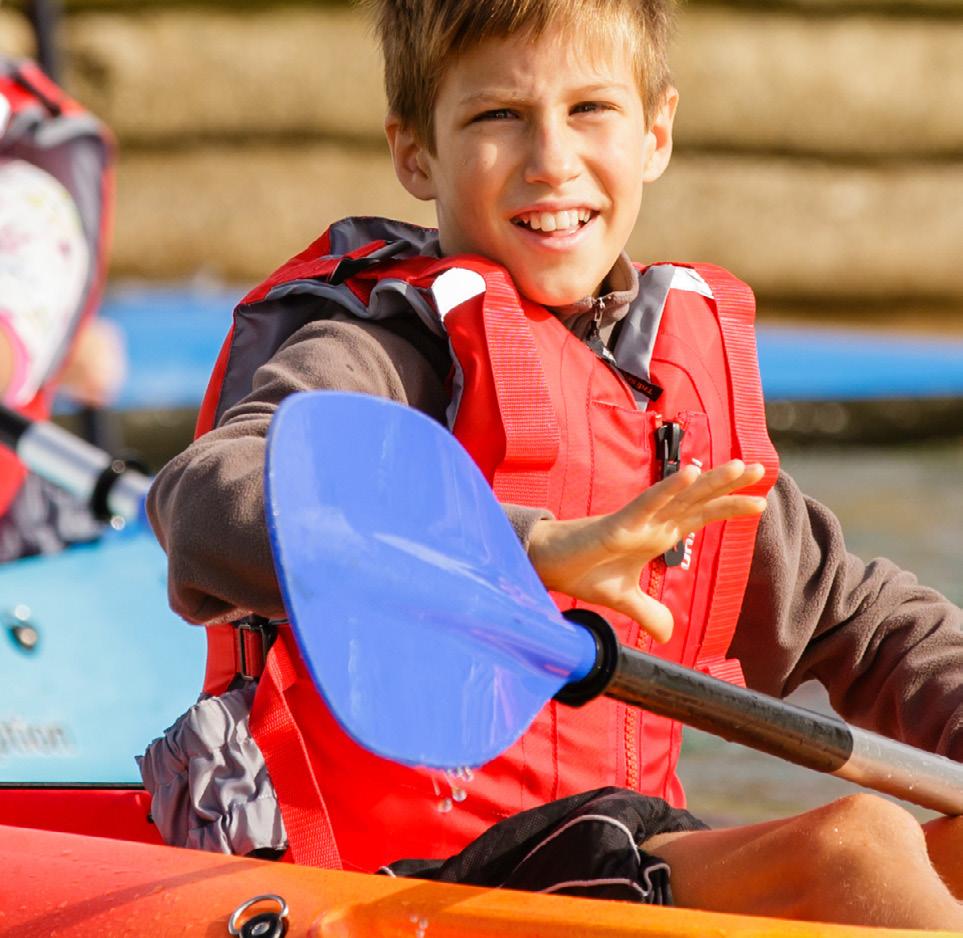
Paddle UK, the national governing body for paddle sports, explains the mental and physical benefits of paddling for the whole family.


Paddling, whether that’s on a stand-up paddleboard, in a kayak or canoe, is a fun activity the whole family can enjoy together. It gets you out in nature, keeps you fit and is great for your mental wellbeing. Getting children into paddling can be hugely rewarding. The memories and pictures taken

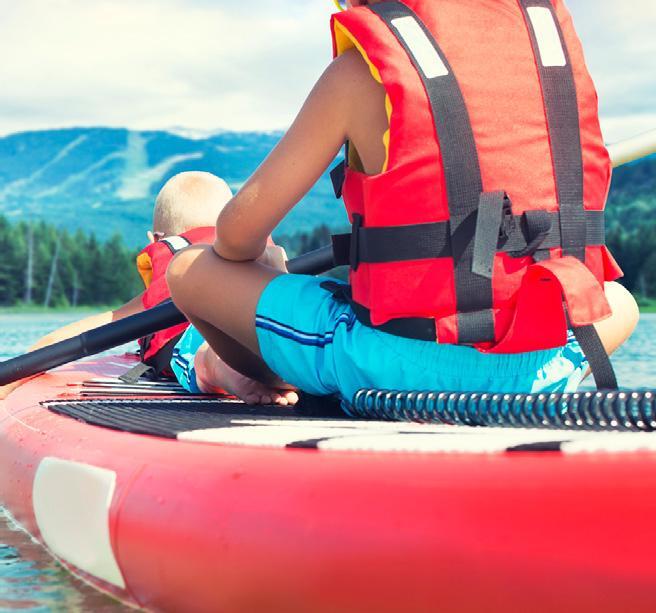
educational experience. Science and nature are vital parts of it all. Do you understand the flow and behaviour of water? How your body and paddle movements affect the craft? And how to interpret weather reports to ensure you stay safe? Knowing these things allow you to make good decisions. When your children are older and have developed their skills, they might be ready to have their own craft alongside you. This will give them a great sense of independence and help build their fitness and confidence, as well as giving them an appreciation for the natural world.
Not only is paddling a great way to explore new places, it also helps you look after your physical and mental health. Studies show that living closer to nature is associated with lower rates of cardiovascular disease, diabetes and obesity. Accessing blue space is something many of us do on a daily or weekly basis, to make ourselves feel happier and healthier. You’ll see improvements by exercising in the ‘blue gym’ more often. For a start, you’ll get more vitamin D. People with low levels of the vitamin, can suffer from low mood and depression. You can boost your levels of vitamin D just by being outside and enjoying the
Paddling can be a very social pursuit, too. You can make new friends and form new social groups with people who have similar interests.

In physical terms, various studies show how paddle sports have been used to improve motor skills, balance, coordination and concentration in people with both physical and mental disabilities. Indeed, multiple studies showed for participants with protected characteristics, the physical health benefits of paddle sports appear to be amplified.
It’s great for weight loss (in adults!) too. An average 80kg person can burn up to 500 calories in an hour’s leisurely paddle on a stand-up paddleboard. This can increase up to 735 calories as the pace is increased. A whole range of muscles are used when paddling, from your arms and shoulders to your legs and back. The majority of them you don’t even realise you are using. The steady movements involved in a leisurely paddle helps to promote healthy muscles and joints.
By keeping your muscles and joints moving, and staying physically fit, you are reducing the risk of injury to them. The low impact nature of paddle sports makes it a perfect sport to do to help build up muscles and joints. Older family members are easily able to join the trip, too. Paddling is a low-impact activity, which puts little strain on joints. It’s possible to take things as gently or high octane as you like.
Visiting a recognised club ycxtuxwm centre
is a good way to start paddling. They’ll have trained staff and all the
equipment you need for a rewarding and safe paddling experience.
Afterwards, we recommend learning the basic skills through a free eLearning course on Paddle Awards (tinyurl.com/2bypjb7p) so that you feel confident taking your kids on the water. Topic areas include key equipment, safety precautions and environmental factors, which are essential for all beginners to know.


Paddle UK is the national governing body for paddle sports, which offer On The Water Family Membership ( paddleuk.org.uk/on-thewater-membership/ ). This waterway licence covers being able to paddle on about 4,500 km of waterways. Public liability insurance, top tips and a range of member discounts and offers are also included in membership. A contribution of the fee goes towards supporting the work that waterway authorities carry out to
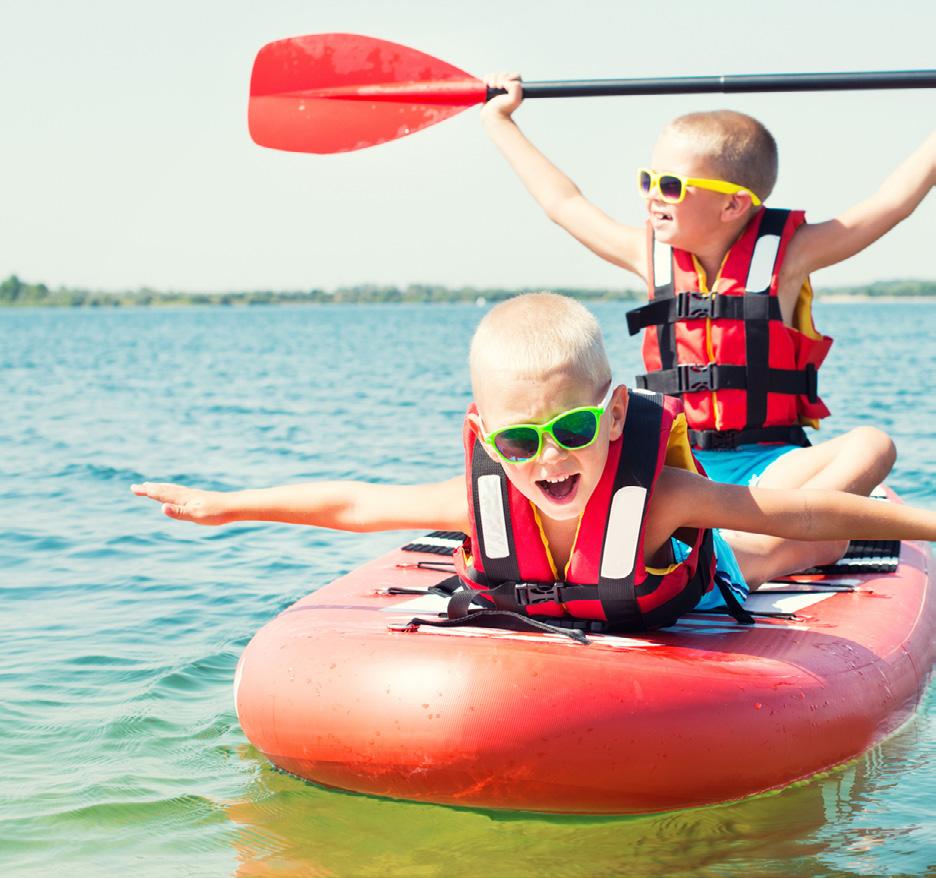
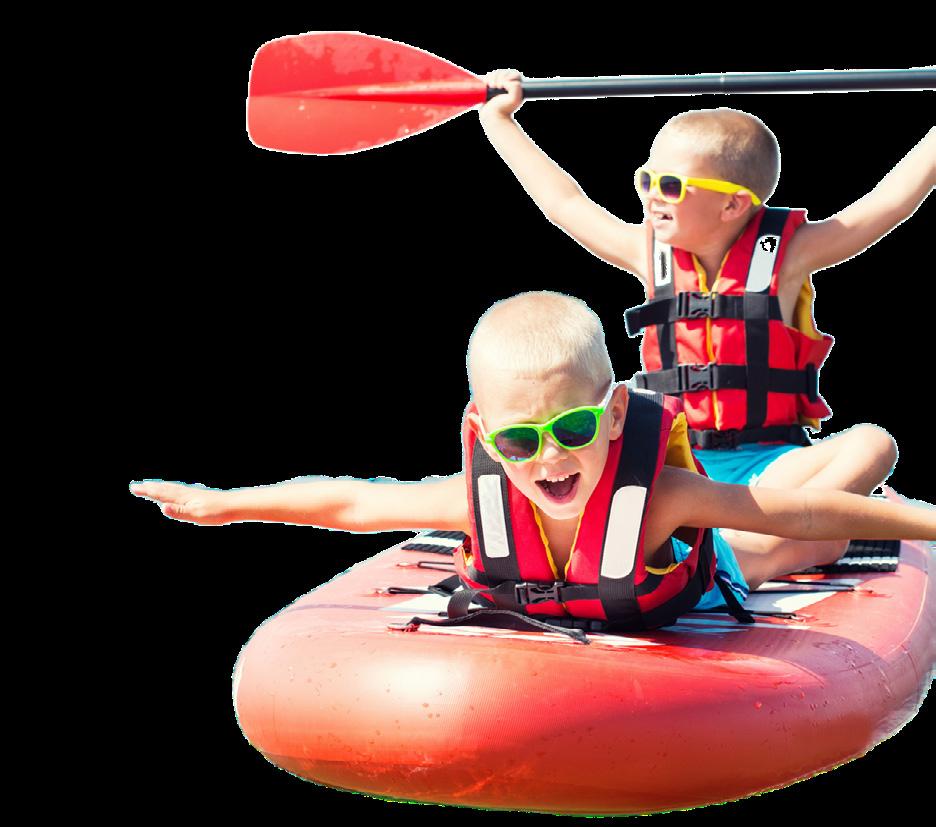
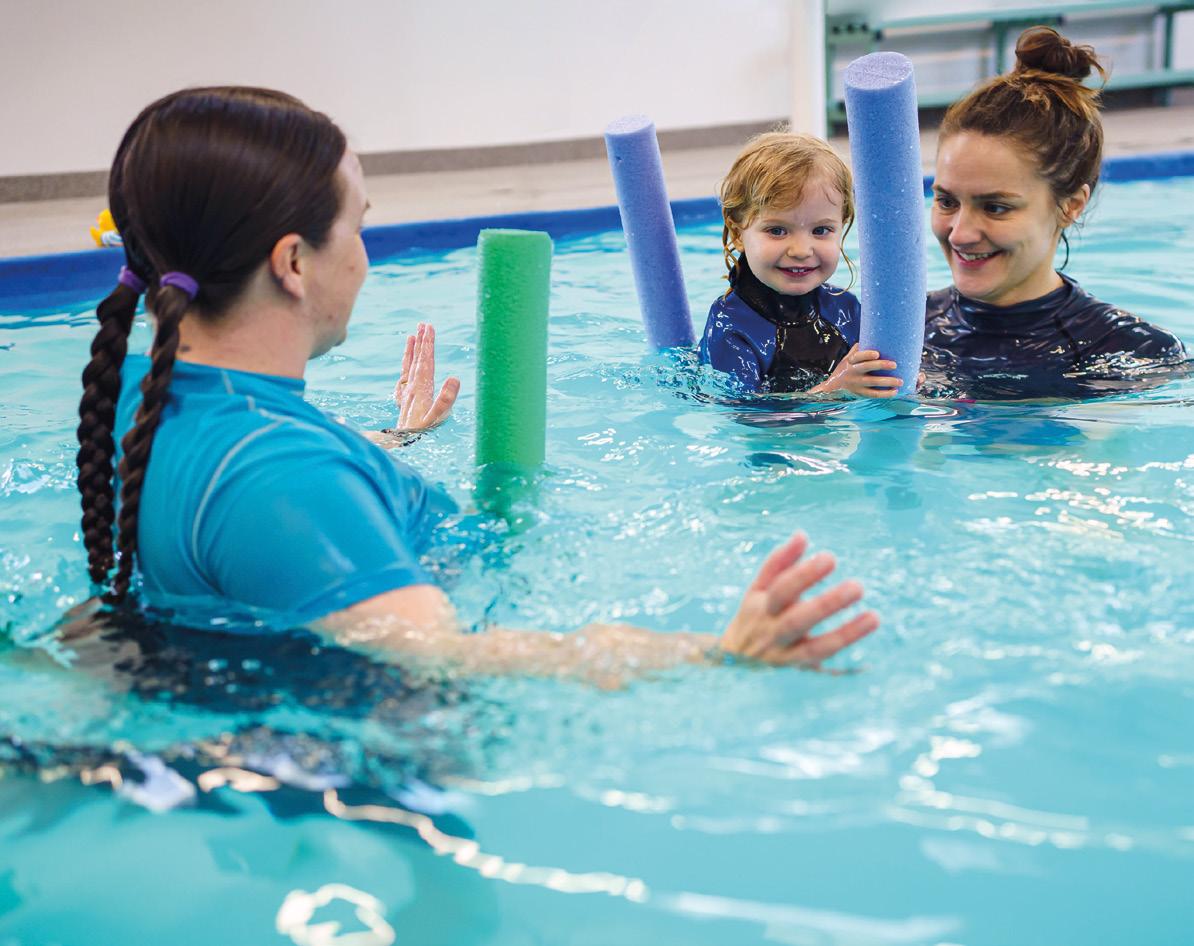
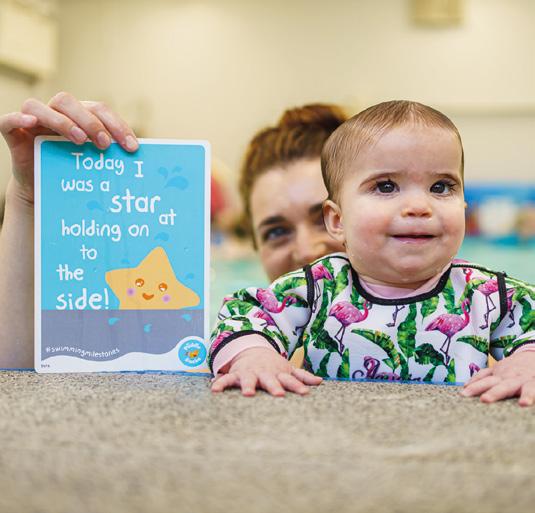

from Mood Interiors looks at how parents can create a space that benefits a child’s mental health and wellbeing through thoughtful and mindful decoration in their safe space – the bedroom.
There is a rise in the prevalence of mental health, especially since the pandemic, where isolation had a significant effect on the emotional wellbeing of all ages. The King’s Fund reported that there has been a rise in emotional disorders in ages 5-15, with anxiety and depression being part of the diagnosis.[1]
I am sure we can all agree, growing up isn’t always easy no matter the generation, but the exposure of social media, a culture of immediacy and increased diagnosis or awareness of neurodiversity is changing the way young people experience childhood. However, there are some positives too, as social media is normalising mental health disorders, making the conversations louder and more actionable. With more resources, charities and support systems available, we are better equipped to accommodate more conditions, thus making the world a more inclusive and diverse place for all.
“Perhaps the only room a young person can truly call their own –the bedroom, can be designed to promote positivity, wellness and calm the senses”
designed spaces to adhere to the safety, hygiene and more recently the mental health of humans. As prevention is the best cure, interior spaces that allow people to live, work and socialise without restriction is undoubtedly going to have a positive impact on their wellbeing. With this in mind, we will explore how –perhaps the only room a young person can truly call their own – the bedroom, can be designed to promote positivity, wellness and calm the senses.
Interior design has historically been thought of as a luxury; perhaps not really an essential part of living but something “nice to have”. As the profession has evolved, there is now a “need” to have functional, sustainable and well-




When we consider wellness and the environment, it is important to delve into the sensory stimulation levels of each individual within that space. There won’t be a one-size-fits-all solution, as sensory processing varies in each of us. However, it is true that the way a room smells, sounds, looks or feels can impact our nervous system. In the bedroom, where children may study, play and sleep, consideration should be how that space promotes calm, focus and relaxation. The way that room is designed and other external factors can enhance the stress relief and sleep quality. [2]
As most bedrooms will be multifunctional, it is important that there is adequate storage and good organisation to avoid a space feeling overwhelming. You could have built-in furniture, under-bed storage or shelving with stylish boxes. Your child should understand, perhaps through labels or pictures, where everything goes. This will make tidying up more efficient and encourage them to take responsibility of their belongings and reduce stress when transitioning from different activities.
Moving from study, to play and to sleep can be seamless if the bedroom layout is clear. Consider ways the room can be visually segmented to encourage the different tasks. For example, blue is the colour that promotes concentration, so could the wall with the desk be painted in blue or another appealing colour? Colour blocking the room is a great way to visually separate the space and for those with neurodiversity clearly navigating what that area is for and aid more focus.
If the space allows, open shelving to split rooms, or moving desks further away from the bed can help the sleep area feel more relaxing and separate from other elements in the room. Again, using feature walls, colour blocking or canopies is a lovely way to make the area for sleep feel more cocooned and cosy. It is worth noting, that you should be mindful when creating focal walls and colour blocking to not create a room that is overstimulating. To avoid this try using complementary colours or materials.
Perhaps an element that has often been overlooked (although Egyptian cotton sheets have been on the menu for a while) is the bedroom textures. The floors, walls and accessories should all be considered to promote the room’s relaxation. Weighted blankets can be used for all ages and is a great way to provide

“Using feature walls, colour blocking or canopies is a lovely way to make the area for sleep feel more cocooned and cosy”
a calming and sensory regulating support for the nervous system during high energy or anxietyinducing situations.
Organic and natural textures, such as organic cotton, wool or hypoallergenic silk, are healthy options to use for bedding. These materials are breathable, avoidant of harsh chemicals and help your body temperature to stay cool or warm aiding a great night’s sleep.
Choosing flooring for the bedroom will vary on preference and usage. If your child suffers from allergies it may be worth considering wood, LVT or even cork flooring. These options are durable, easy to clean and if you have the choice of heated floors, this can make it more appealing for the feet too. If your child likes sitting on the floor, washable rugs are a lovely addition, or padded floor mats so they can read, roll or rest as they wish. Giving versatility to the space, and options for different areas for your child to move into, can help them to feel more at ease and able to self-regulate. Carpet is also a great option for softness and comes in a variety of materials for durability and function, however it can be harder to clean depending on the age of your child.
You will no doubt know that natural light is always the best option for a space. The internal chemical reaction we experience from day to night supports our circadian rhythm and promotes sleep and rest. So if you are blessed with natural light in your child’s bedroom, choose window treatments that control this. In the day time, you want to allow the light in as much as possible, and if privacy isn’t an issue I would consider no blinds or blinds that roll up, to avoid blocking out daylight. However, in the night time you do want to give your child the best chance of sleep,



so blackout curtains are a lovely option and come in an array of fabrics and colours, too.
Perhaps you never considered the above approaches or realised how much of an impact a well-designed and personal space could have on your child, or anyone. Interior design can creatively promote one’s self esteem and security by acting like a place of restoration, retreat and sanctuary. It is important to consider the longevity of furniture, through reuse or restore elements as your child grows. This can be either repainting, reupholstering or even buying second hand. Protecting the environment while promoting wellbeing within the home is beneficial for all, so be mindful when buying new furniture and ensure the quality and longevity as much as possible.
“Bubble tubes, lava lamps or soft multi LED lights help the room feel calm and relaxed”
Having enough task lighting around the bedroom creates ease. There is nothing more annoying than having to get out of a warm bed, to turn off a light when you are done reading. So ensure that lights that aid tasks, like reading, studying or doing make-up, are well placed and also within easy reach to operate too.



Sensory or mood lighting is an option for children and adults alike. Bubble tubes, lava lamps or soft multi LED lights help the room feel calm and relaxed. The use of sensory lighting has been a staple part of rooms for neurodiverse individuals for many years, however incorporating this into everyone’s everyday would benefit and promote the calm and relaxing environment you’re aspiring for.
Colour and pattern is very personal, and although there are theories of colour in interior design, it would be best to begin the choice through discussion with your child. Colours evoke different feelings and as a general rule of thumb, red depicts strength, pink for love, yellow for optimism, blue for relaxation and green for harmony. There are different ways to incorporate colour, whether it is colour drenching an entire space for a cocooned feel or adding more minimal pops through accessories. It is important that the room feels personal, comforting and inviting for your child, so consider patterns or pictures that reflect their interests, hobbies or passions. Personal items promote the sense of belonging in a space and although you may twitch at the idea of your child choosing their own paints and pictures, it would be best to at least involve them at this stage, so they can truly feel a sense of pride within their bedroom.
Preet Anand founded Mood Interiors in 2016 alongside her business partner Bal Dhanoa. Mood Interiors is dedicated to transforming spaces into harmonious sanctuaries that nurture well-being, mental health, and inclusivity. Book a free 30-minute online interior consultation via info@moodinteriors.co.uk More information on Mood Interiors can be found at moodinteriors. co.uk or by following their Instagram: Mood Interiors: Designing for Wellness
Sources
1. Mental Health 360 | Prevalence | The King’s Fund
2. Multi-Sensory Stimuli Improve Relaxation and Sleep Quality in Rotating Shift Workers: A Randomized Controlled Trial - PMC
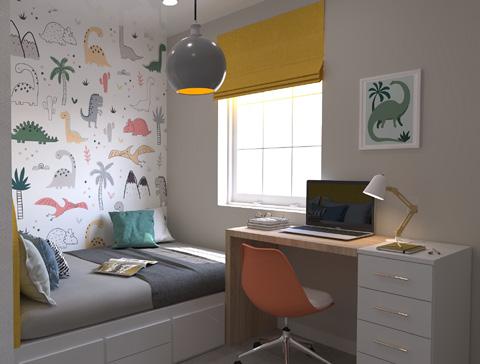



Spotting the signs that something is wrong with your child’s eyesight isn’t always easy, especially as it may be difficult for them to articulate that their vision is impaired. Mark Shelton, Optometrist at Bayfields Opticians and Audiologists, shares the signs to look out for and the treatment options available.
Eyesight is a crucial part of a child’s development and vision problems can have a real knock-on effect on their social, academic and physical development, as well as leading to further issues with their sight. So it’s important to be aware of the signs that your child may need some extra help and know how to get your children’s eyesight back on track.
Squinting or rubbing the eyes is a classic sign of visual impairment, as people do this to reduce the amount of light entering the eyes and improve focus – and our children are no different. If you notice your child doing this as they are trying to focus on an object, whether in the distance or up close when reading a book for example, it could be a sign they need glasses.

Does your child often sit very close to the TV or hold a book unusually close to their face? This could indicate vision problems, such as myopia, otherwise known as short sightedness. This condition leads to children having difficulty seeing things far away, so they get as close as possible when trying to concentrate on a screen
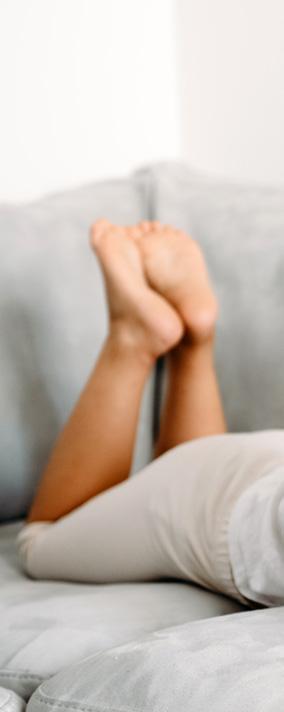
and books, to counteract this. Sometimes children might even purposefully close one eye when trying to read. Over the longer term, this can lead to eye strain and cause vision to deteriorate further over time.
A change in the condition of young eyes can affect other things, too. For example, there might be sudden changes in their academic performance at school, they might demonstrate confusion when doing certain activities or show a lack of focus when you’re interacting with them. Additionally, they might be unusually clumsy or struggle with hand-eye coordination.
Children who struggle to focus their vision can suffer from eye strain, which manifests in headaches. While there can be several reasons a child complains of a sore head, stay vigilant for headaches that occur when they have been doing tasks that rely on focusing visually, such as reading a book.
The school holiday childcare juggle is challenging for many parents and can result in more screen time. But spending a lot of time looking at digital screens has a real toll on our eyes, as well as increasing the risk of developing myopia. The likelihood of developing this condition is 3.5 times greater when children spend seven hours or more on screens, so it’s important to manage daily screen time over the holidays.
Studies show that spending even just a couple of hours a day outside can reduce the likelihood of children developing myopia. It can also stop further deterioration of the eyes. The more natural light helps eyes to develop properly, as well as getting them away from close-up activities like screens and reading, which are more common indoors.
Getting your child to eat a healthy, balanced diet can be challenging, but it’s good to be aware of the foods that contribute to good eye health, such as fruit, vegetables and fish – and incorporate them into your child’s meals where possible.
Should you have any concerns about your child’s vision, it’s important to see an optometrist to prevent any further deterioration or wider impact on your child’s health, wellbeing and development.
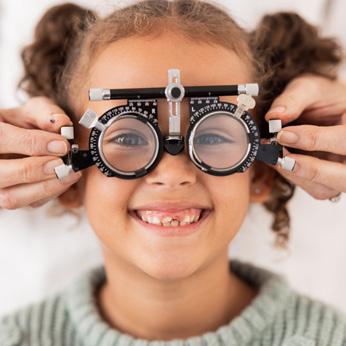

“Does your child often sit very close to the TV or hold a book unusually close to their face?”
Eye examinations are available for free on the NHS for under16s or anyone aged between 16 and 18 and in full-time education. Trained optometrists will examine overall eye health, as well as vision. The College of Optometrists recommends children have their eyes tested regularly from three years old. For children aged 4 to 5, there may be a vision screening available at their school, but this only checks for some common vision problems. If a vision screening is not available in your local area, you can take them to see your local optometrist for a sight test, where a detailed eye examination can pick up vision or eye health problems.
For more information on Bayfields Opticians and Audiologists, visit: bayfieldsopticians.com

Co-founders of the Allergy Centre of Excellence (ACE), Professors Adam Fox, Gideon Lack and George du Toit, share advice on diagnosing allergies and the best ways for parents to manage them.
What’s the difference between food intolerances and allergies?
It’s important to distinguish between food allergies and intolerances –which your GP can help with –because management and treatment are very different. An intolerance, while unpleasant, Q

isn’t dangerous. A common example is lactose, where the body lacks the enzyme to break down the sugar found in milk, which can lead to symptoms such as bloating, abdominal discomfort, wind and diarrhoea.
An allergy involves the immune system reacting inappropriately to something harmless, such as peanut protein or grass pollen. It typically results in an immediate response such as hives and swelling, or in more uncommon but severe cases, wheezing or breathing difficulties. In the most severe form, it can be life-threatening – this type of reaction is called anaphylaxis.

How do I know if my child has a food allergy and what are the most common types?
One of the first symptoms in young babies and children is aversion – often this means that when they’re fed, they turn their head away, arch their back or spit out the food. However, this can often happen with children who don’t have an allergy, so it’s good to look out
for other signs.
The most common visible sign is on the skin – hives or flushing around the face, which can extend to the body. These rashes can be itchy and lead to the lips and/or eyes swelling. The most common food allergies are egg, milk, peanuts, tree nuts and sesame. However, others include peas, lentils and kiwi and, for older children, it can also include fish and shellfish.


It’s important to stay calm because more often than not it will be a mild reaction. Firstly, you should stop giving your child the food and wipe it off their mouth and skin. Also avoid the suspected food until a diagnosis has been confirmed, especially if the initial reaction was severe.
For moderate symptoms, book an appointment with your GP as soon as possible. Describe the symptoms, including the reaction's timing, duration and nature, and explain that you suspect an allergy. They will be able to advise on the next steps and treatment options.
However, if your child has a severe reaction or symptoms of anaphylaxis (restricted breathing or blood circulation), it’s best to call 999. It’s also worth considering joining a support group, like Allergy UK or The Anaphylaxis Campaign. They offer helpful advice, resources and support for families, and have useful helplines to call.
There are a variety of ways to do this. Avoiding the food as much as possible will help to minimise risk. This can be done through clear communication with caterers and checking food labels on products. Likewise, understanding how the ‘may contain’ warnings on products will affect your child.
You should also let the school/pre-school/ nursery/restaurants know and make sure your family and friends are fully aware of the diagnosis, including symptoms and how to manage these reactions. To help with this, your doctor should give you an ‘Allergy Action Plan’, which you can give out to people – it’s a really effective way to keep your child safe in different scenarios.
It's also important to know how to respond to a reaction, especially if it’s severe. The consultant who diagnosed the allergy will be able to tell you
what’s best, which may include carrying an adrenaline injector (Epipen or Jext). You’ll need to make sure you/your child/your child’s care setting has access to this all the time and knows when to use it. It’s also good to have regular check-ups with your GP/consultant because allergies can change over time and some children outgrow them.
After many years of avoidance being the only option, new and innovative ways to prevent and manage allergies are available. For example, our clinic offers oral immunotherapy (often referred to as OIT) for foods such as peanuts, sesame, tree nuts, wheat, milk, egg and legumes. Under the guidance of the team, a child eats small but increasing amounts of the food to make them
less sensitive, while protecting them from accidental exposures.
“An intolerance, while unpleasant, isn’t dangerous”
Babies and children who are suitable for this type of support and have successfully gone through the process, have seen their risk of reactions significantly reduced. And, as a result, this has made a big difference in the family’s life and management of the allergy; for example, in restaurants, at birthday parties and on aeroplanes etc.

“After many years of avoidance being the only option, new and innovative ways to prevent and manage allergies are available”
New medicines are also becoming available such as Omalizumab. Taken either on its own or alongside OIT, it can significantly reduce sensitivity and the severity of reactions. A new nasal device to treat anaphylaxis will become available later this year. At the moment, children have to be injected, so this will be a great alternative that should mean individuals are less nervous about using these life-saving treatments.
If you suspect your child has an allergy or they’ve already been diagnosed, it’s best to speak to your GP. They can advise on the next steps, including potentially referring you to an NHS paediatric allergy clinic and speaking to a specialist. Waiting times can be lengthy, so it’s good to consider taking

However, there are private specialists who can offer faster access – these can be accessed through health insurance or direct payment. The British Society for Allergy and Clinical Immunology website (bsaci.org) has a list of NHS allergy clinics.


ACE is dedicated to offering personalised, innovative treatment options to babies and children for food allergies, including OIT. The specialist team provides tailored care plans for families that are proven to help reduce and eliminate hypersensitivities. More information can be found at allergycentre.
co.uk Article by Natalie Chishick
How do you work out your portion sizes at mealtimes? Nutrition expert, Bridget Benelam from the British Nutrition Foundation offers key advice on portion sizes, seconds and snacking.
New research on behalf of the British Nutrition Foundation (BNF) has revealed that many parents aren’t confident when it comes to serving the right portion sizes to their children. The BNF is helping parents to Get Portion Wise and check the portion sizes they are eating and serving to their children.
The survey, conducted among parents across Great Britain with children aged under 18 years, reveals that over half (57%) of parents use ‘visual estimation’ when deciding how much food to serve themselves, while only 15% measure their portions and 14% follow package instructions.
When thinking about how much their children should eat, 51% of parents judge portion sizes based on how much their children usually eat and 16% say they let their children serve their own portions. More than a third (37%) of parents always or often make their children eat everything on their plate, and a further 23% sometimes insist their children finish everything they are served.

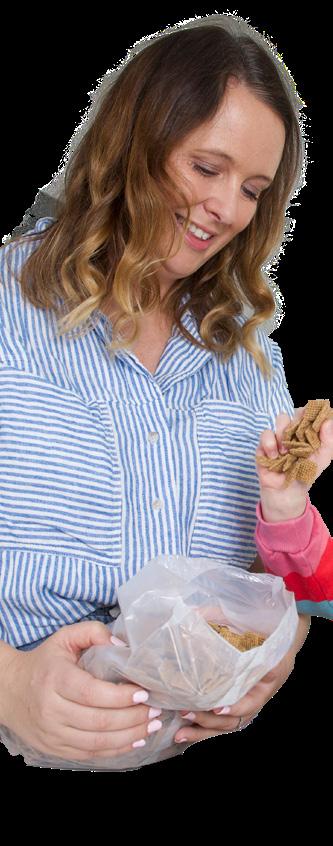
“There is not just one ‘right’ portion size for everyone”




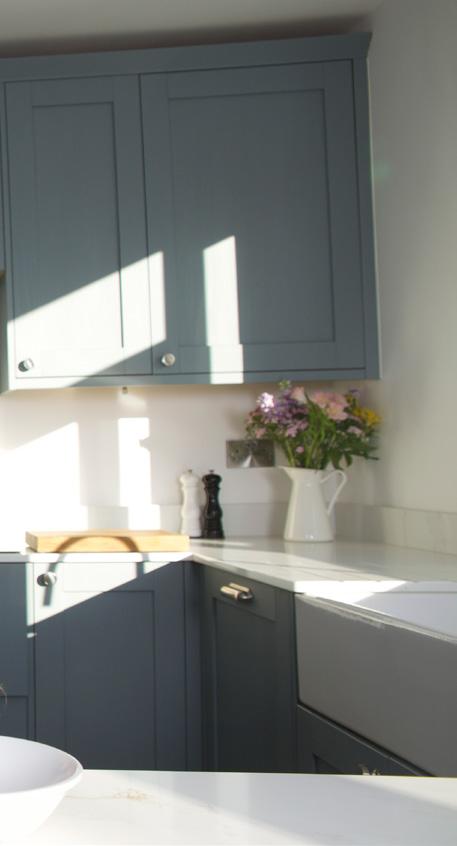
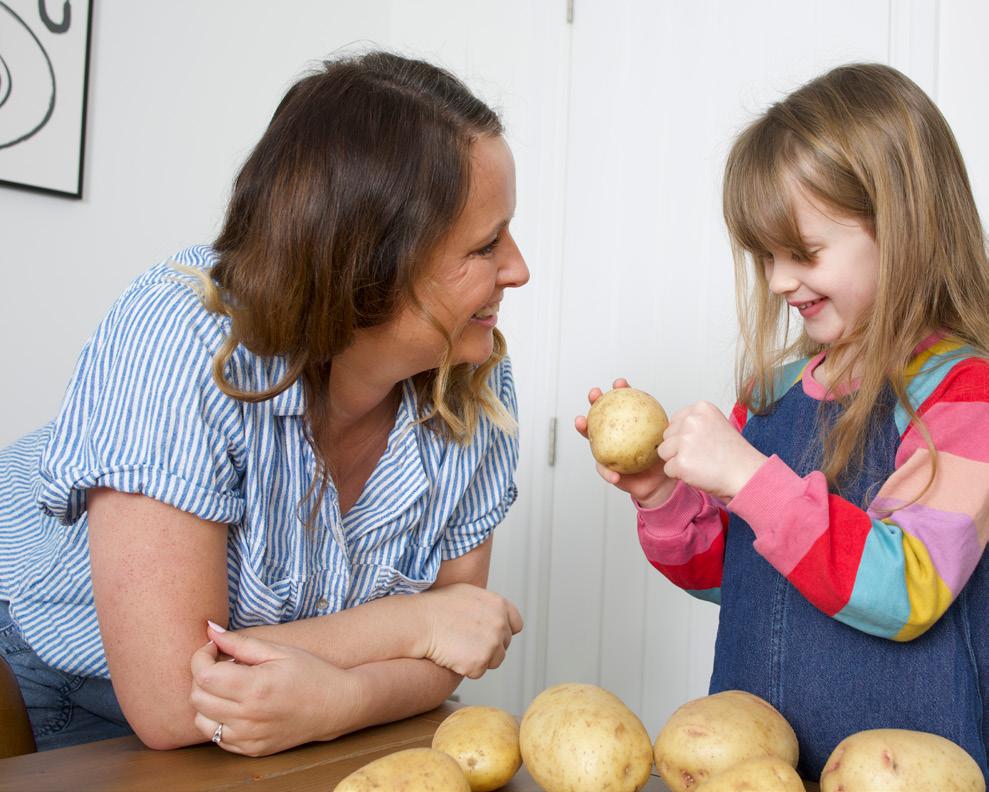




“A practical way to judge an appropriate portion size can be to use your hand, or your child’s hand, as a guide”
As parents, one of the most important ways we can support our children’s health is by ensuring they eat a balanced diet. But today’s environment can make it hard to follow a healthy diet, which means that, at home, we also have a vital role to play in ensuring members of our family are eating the right balance of foods in appropriate portion sizes.
There is not just one ‘right’ portion size for everyone. The amount we should each eat depends on our age, height, build and activity levels. So, what’s right for an adult will not be appropriate for a child.
Offering children portions that are too large can encourage overeating, while serving appropriate portions will help them become attuned to their own appetite and develop healthy eating habits.
We also shouldn’t encourage children to eat everything on their plates. Instead, let them decide when they are full.
A practical way to judge an appropriate portion size can be to use your hand, or your child’s hand, as a guide. For example,
the portion of dried pasta will equate to around two of an individual’s handfuls, while an appropriate portion of chicken breast, will be about the size of a hand, outstretched and with fingers closed together.
At the BNF, we also recommend starting with smaller portions for children and allowing them to have a second helping if they’re still hungry. Serving children’s meals on smaller plates can also help you to control portion sizes.


Every meal should aim to include a mix of the main food groups. Here’s a quick guide to keep in mind:
Fruit and vegetables: Serve plenty at every meal. Encourage your family to eat at least five portions of fruit and vegetables daily, as they are high in essential vitamins, minerals and fibre. Try incorporating them in fun ways, such as veggie sticks with dips or fruit salads.
Carbohydrates: Foods like potatoes, rice and pasta provide energy, but if portions are too large, this can mean excess calories. Use the above hand measure for pasta and rice; an appropriate-sized jacket potato will be about the size of an individual’s closed fist.
Protein: Meat, fish, eggs, beans and plantbased alternatives are key protein sources for growth and repair. For white meat and fish, the appropriate portion will be about the size of a hand, while for red meat, we recommend around the size of an individual’s palm.
Dairy: These are an important source of calcium and other nutrients. A small pot of yogurt or a piece of cheese that is about the size of two thumbs is a good guide for both children and adults.
Healthy snacks can help bridge hunger between meals while providing key nutrients. Ideas include oatcakes with soft cheese, veggie sticks with houmous or natural yogurt with some fruit. It’s also a good idea to keep portion sizes of ‘treat’ foods like chocolate, fried crisps, biscuits and cake to small portions and to have them less often
By making small, practical changes, families can manage portion sizes while still enjoying food together. Being portion-wise isn’t about strict rules; it’s about finding a balance that works for everyone and sets the foundations for healthy habits that last a lifetime.
The British Nutrition Foundation is a charity that strives to prevent diet-related illness and promote health and wellbeing through evidence-based nutrition science. It provides a bridge between nutrition science, government, industry, healthcare, education and people, and is a conduit to a healthier, more sustainable food environment for all. Find out more at: nutrition.org.uk
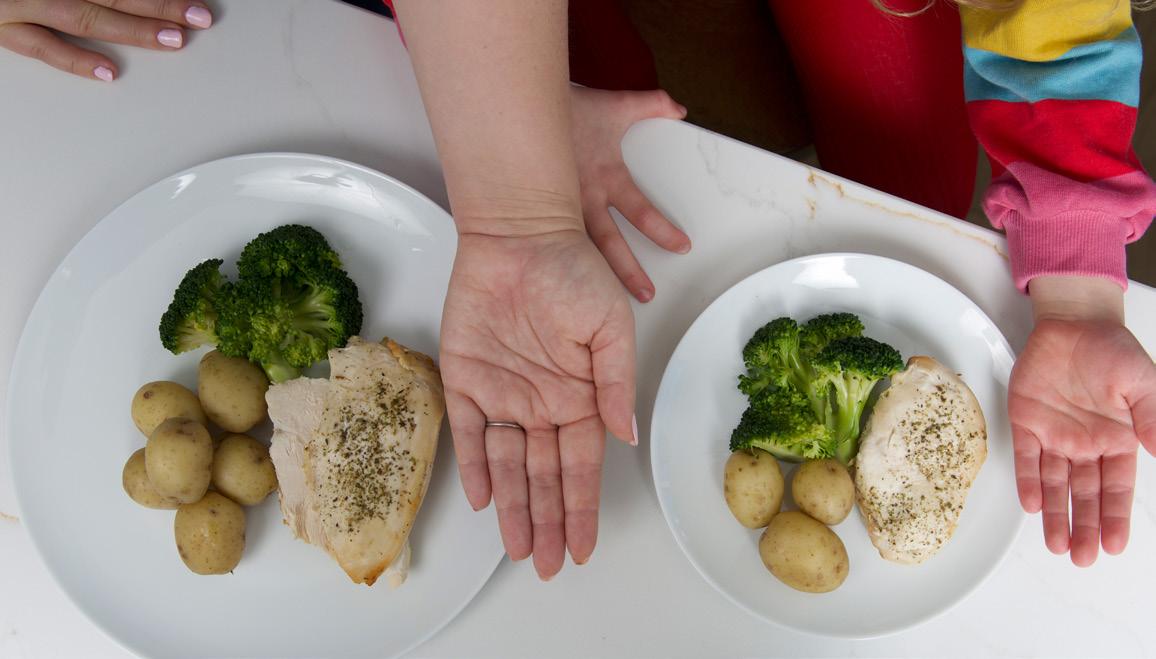

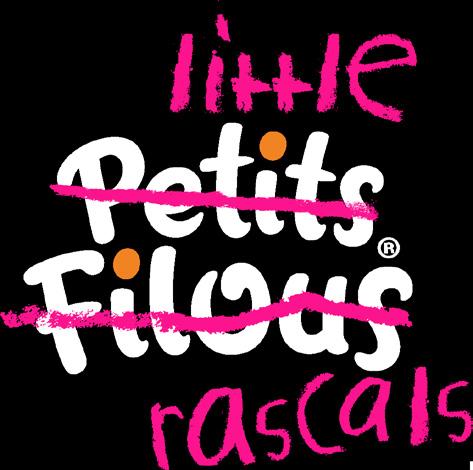

Health and plant-based food gurus, Steve and Dave Flynn from The Happy Pear, share their top tips for parents who want to increase the number of plants in their kids’ diet.
The Happy Pear have spent the last 20 years campaigning to encourage everyone to eat more vegetables and to increase their fibre intake. With six children between them, brothers Steve and Dave are experts on finding ways to up the greens (and reds, purples and oranges) on your plate!

For anyone who struggles to eat veg, why not blend some into a smooth soup? This is a great way to pack in loads of veg without the kids even noticing.
3 4
Join the smoothie gang! Dave makes a big smoothie for his teenage daughter every morning before school, which includes frozen berries, blueberries, banana, almond butter, seeds, Carrageen moss (for her skin) and a little apple juice and water. You can even add in some spinach, kale or avocado to increase the veg content.
“Try introducing porridge in the morning instead of cereal, as it is the perfect vehicle for a range of healthy toppings”
To celebrate 20 years in the food business, here are their top 20 tips to get the family feasting on more vegetables:
1
Start with fruit rather than veg, as it is sweeter. those fruits that are in season as they will be more full of flavour and, therefore, much tastier.
2
Try introducing porridge in the morning instead of cereal, it is the perfect vehicle for a range of healthy toppings, such as berries, seeds, caramelised banana or nut butters.
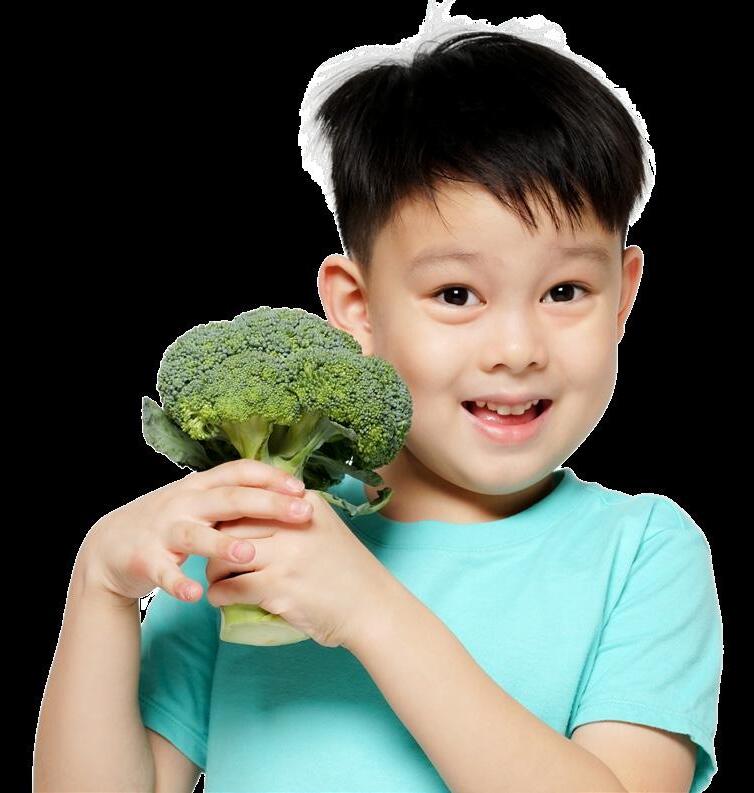
Try to include a little extra veg to dinner; some sliced avocado or cherry tomatoes with a chilli are great options, blending beautifully with the spices and ramping up the nutrients.
Add tinned beans, lentils or chickpeas to a curry to increase the fibre content. Beans are also high in protein and a great source of energy, so they are a brilliant addition at mealtimes.
Use wholewheat or wholegrain pasta instead of white pasta. It’s higher in fibre and much better for your microbiome and a really easy switch. Although not technically veg, it’s a healthier choice nonetheless.
Consider cooking more Thai or Mexican meals, as these types of foods lend themselves really well to be packed with extra veg and have loads of flavour.
5 7 9 6 8 10 11 12
Encourage kids to snack on dried fruit if they don’t like fresh fruit, as it is still full of nutrients. Just make sure they brush their teeth, as many dentists believe that the fructose can stick to the tooth enamel, encouraging tooth decay.
“Bulk roast sweet potatoes in the oven or airfryer – they are often a favourite with kids, as they are easy to eat”
and other nutrients, and are really inexpensive. The brothers’ favourites are red lentils, which can easily be mixed into curries or soups.
Bulk roast sweet potatoes in the oven or airfryer – they are often a favourite with kids, as they are easy to eat, sweet and tasty. Do a big batch and store them in the fridge, so you can eat them as part of your dinner without the hassle.

Expand your horizons when it comes to salad. Instead of thinking of lettuce, tomato and cucumber as the only type of salad, try including beans, avocado, roasted sweet potato or butternut squash. You can even add brown rice or lentils for more fibre and to make it more filling.
13
Make a plant-based burger with blended cooked veg, beans and grated root veg. No one will know what is in it and given all the added sauces and condiments it is a great way to sneak extra veg in.

Cut up vegetables at the start of the week and store them in the fridge as an easy snack for after school. The kids can enjoy them with hummus or guacamole for extra veg and fibre. Or roast some tinned chickpeas or beans in the airfryer with tamari and nutritional yeast for ten minutes. These make a delicious snack for any time of the day.
Add some frozen spinach to any soups, chillies, stews, curries or dahls to bump up the nutrient profile.
Introduce sprouts, such as broccoli or alfalfa, to sandwiches. They are believed to be 10-30 times more nutritious than the healthiest veg by weight.
Look at introducing one plantbased meal a week and choose an easy one the whole family will enjoy, such as a veg-packed tomato pasta bake or creamy mushroom linguine.
Try making some fermented foods; they are literally homemade probiotics that build up your gut health and immune system and cost pennies to make. Involve the kids in making sauerkraut and basic ferments to add to salads or sandwiches.
The Happy Pear are pioneers of promoting a plant-based diet. They have published seven cookbooks promoting the benefits of a wholefood, plant-based diet, they also offer 15 online courses with more than 100k participants, run a recipe club with over 700 recipes on the website and have a social media following of nearly 2m. The Happy Pear also produces a range of award-winning healthy food products including pesto, hummus, granola, snacks and drinks. Their latest cookbook, The Happy Pear 20, celebrates 20 years in the industry. For more information on The Happy Pear, recipes, their food product range and for health inspiration visit https://thehappypear.ie/
“Involve your kids in the cooking and preparation, that way they are more invested and likely to be curious to try the end product”

Involve your kids in the cooking and preparation, that way they are more invested and likely to be curious to try the end product.
14 16 18 20 15 17 19
Even better, try to encourage your kids to help grow some veg, herbs or even fruit, as they will be super interested in tasting the produce if they’ve grown and nurtured it themselves.
See pages 79-81 to view some of The Happy Pear’s delicious recipes.
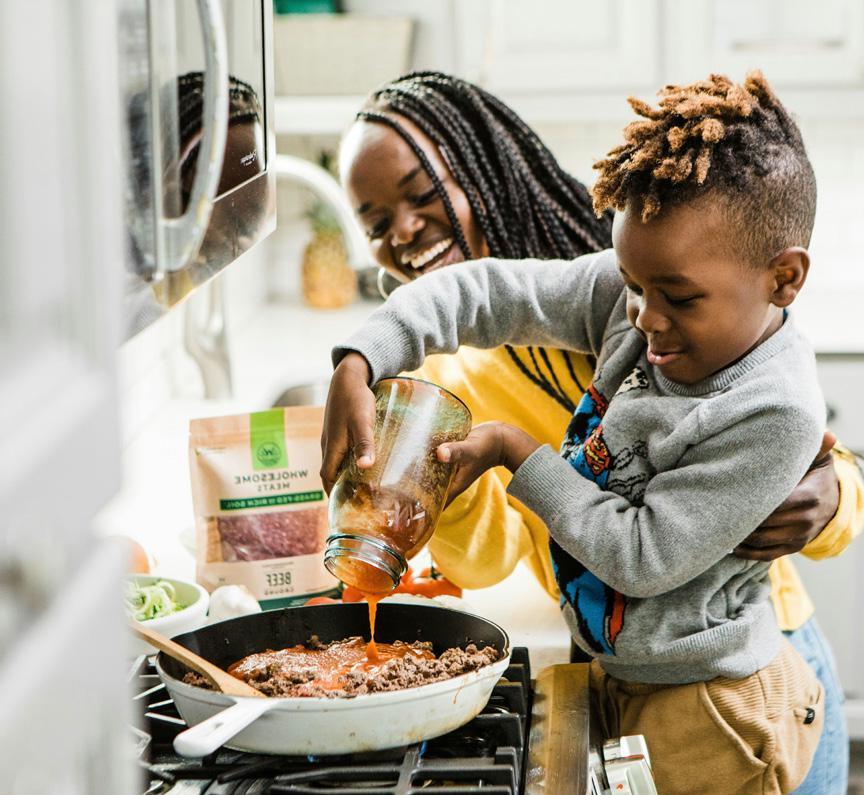
Didknow?you
Not only are beets good for you, but they’re a great natural sweetener

When we wrote our first book this was one of the standout recipes, says Steve and Dave Flynn. Here is an even better version that is quicker to make and packed full of flavour.
- 60g cashew nuts
- 140g walnuts
- 400g raw beetroot
- 10 scallions (or 6 spring onions)
- 80g vegan cheddar-style cheese
- 4 tbsp fresh mint, finely chopped (about 20g unpicked)
- 3 tbsp oil
- 100g breadcrumbs
- 1 lemon
- 150g hummus
- salt and black pepper
1
Soak the cashews: Place the cashews in a bowl and cover with boiling water. Let them soak for 10 minutes.
2
Toast the walnuts: Preheat the oven to 180°C. Roughly chop the walnuts, spread them on a baking tray, and toast in the oven for 6-7 minutes. Remove and set aside.
3
Prepare the vegetables and cheese: Peel the beetroot and grate it. Finely chop the scallions. Grate the vegan cheddar-style cheese. Pick and finely chop the mint leaves.
4
Cook the beetroot and scallions: Heat a frying pan over medium heat, add 1 tablespoon of oil, then the grated beetroot, chopped scallions and 1 teaspoon of salt. Cook for 4–5 minutes, stirring regularly. Transfer to a large bowl to cool.
5
Process the cashew mixture: Drain the soaked cashews. In a blender (an immersion blender can be used for this) or food processor, combine the cashews with 2 tablespoons of oil, the juice of 1⁄2 the lemon, 1⁄4 tsp of salt and a pinch of black pepper. Blend until smooth.
6
Make the burgers: To the large bowl with the cooked beetroot and scallions, add the processed cashew mixture, grated vegan cheese, toasted walnuts, breadcrumbs, juice of the remaining 1⁄2 lemon, chopped mint, and another 1⁄2 teaspoon of salt and 1⁄4 teaspoon of black pepper. Mix well and adjust the seasoning to taste.
7
Shape the burgers: Divide the mixture into four equal portions, about 170g each. Shape into burger patties and place on a baking tray lined with parchment paper.
8
Bake the burgers: Bake the patties in the preheated oven for 25 minutes, or until they are firm and golden.
9
Serve: Remove the burgers from the oven. Top each one with a generous dollop of hummus and serve immediately.
Steve’s kids adore these and don’t even realise they’re eating lentils – pastry is a great way to disguise them! These are so good: sweet, earthy, crispy and chewy. They make a perfect healthier snack.
- 1 × 400g tin of cooked lentils
- 2 cloves garlic
- 1 medium red onion
- 1 tbsp oil
- 3 tbsp maple syrup
- 3 tbsp balsamic vinegar
- 2 tbsp tamari or soy sauce
- 100g cashew nuts
- 1 × 320g sheet of vegan puff pastry, defrosted if frozen
- 50ml oat milk or non-dairy milk of choice
- 2 tbsp sesame seeds
- salt and ground black pepper
1
Preheat the oven and line the tray: Preheat the oven to 200°C fan/425°F/gas 7. Line a baking tray with baking parchment.
2
Prep the lentils and veg: Drain and rinse the lentils. Peel and finely chop the garlic, and peel and cut the onion into thin slices.
3
Caramelise the onion and add the lentils: Add 1 tablespoon of oil to a pan over a high heat. Once hot, add the sliced onion, a pinch of salt and a pinch of black pepper and cook on a medium heat for 5 minutes, stirring occasionally, until the onions are nicely browned and softened. Add the chopped garlic, maple syrup and balsamic vinegar, mix well to coat the onions, reduce to a low heat, and cook for 3-4 minutes, stirring regularly, until the onions are nice and soft and sticky. Add the drained lentils and tamari or soy sauce and cook for 3-4 minutes, stirring occasionally, to evaporate any extra moisture. Remove from the heat.
4
Pulse in a blender or food processor and season to taste: In a food processor or blender, add the cashews, and pulse until they reach a rough breadcrumb consistency. Add the onion-and-lentil mixture and 1⁄2 teaspoon of ground black pepper, and pulse until the mixture comes together but is not too smooth. You want to ensure there’s a slight bite to the filling. Taste and season with salt and pepper to your liking. Remove from the food processor and divide into 4 × 80g chunks and then roll each into a sausage shape about 12-13cm long.
5
Roll out puff pastry: Roll out the puff pastry and cut into four even rectangles, about 12cm × 16cm. Place a sausage at one side of a pastry rectangle, 2-3cm in from the edge. Brush some oat milk along the other side, then roll the sausage up in the pastry until it overlaps and press gently along the seam to seal. Then place the sausage roll seam-side down and gently press down on it with the palm of your hand to help seal it more and to ensure it stays rolled when you bake it. Repeat with the remaining sausages and pastry.
6
Brush with oat milk and bake: Using a pastry brush, brush each sausage roll with a light coating of oat milk (this will help them to brown), then sprinkle with the sesame seeds, place on a parchment-lined baking tray and bake for 20 minutes, or until the pastry is golden brown.

“These are so good: sweet, earthy, crispy and chewy. They make a perfect healthier snack”
“Fibre and protein are important parts of a healthy breakfast and will help your kids to feel fuller for longer”
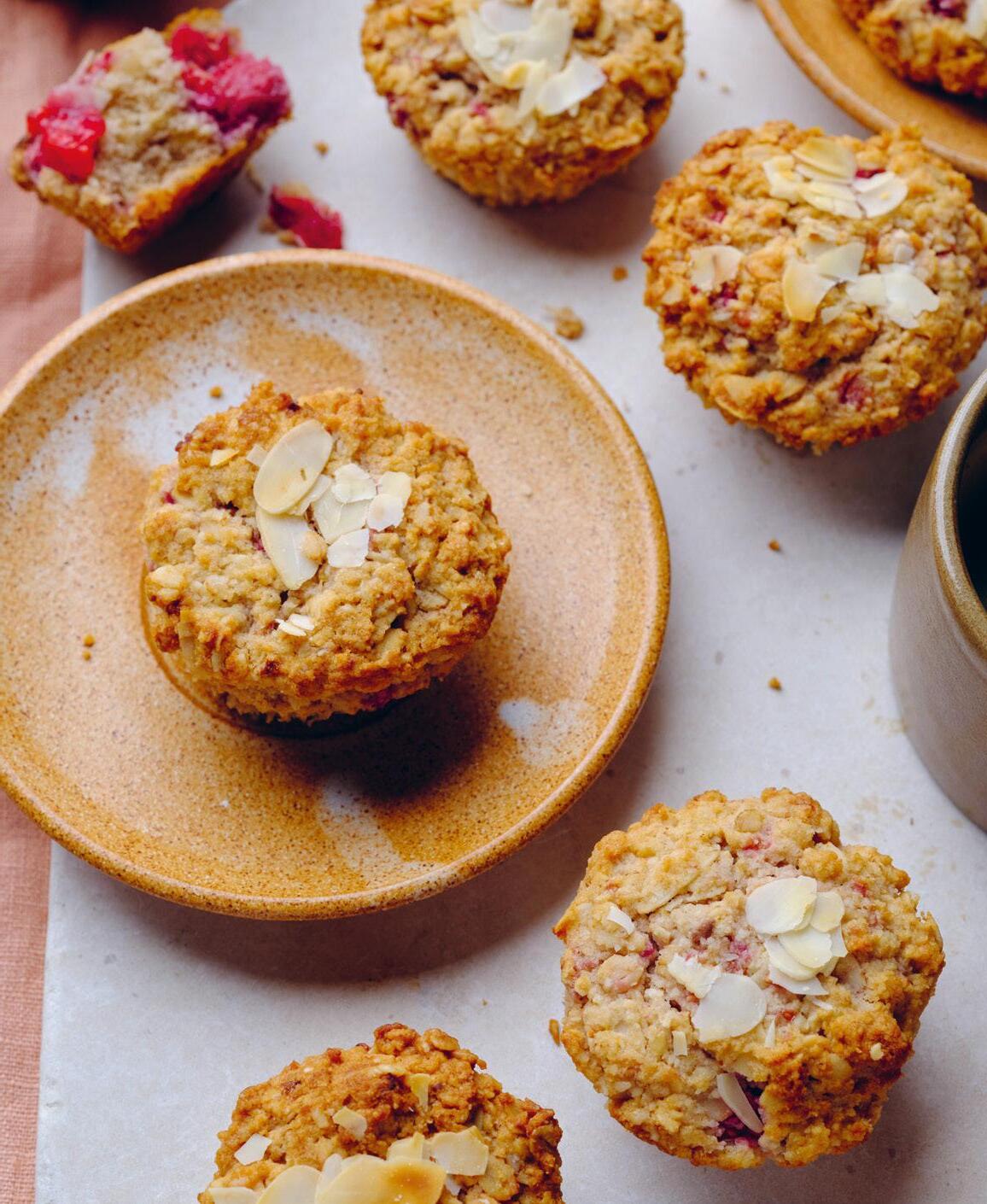
MAKES: 12
These were a very popular breakfast muffin or snack on our first guthealth course. They can be easily made gluten-free and are very easy to eat! We’ve adjusted them slightly to make them more of a summer Bakewell-flapjack-muffin.
- 2 tbsp ground flaxseeds
- 6 tbsp water
- 180g oats (use gluten-free for GF version)
- 50g flour (use gluten-free for GF version)
- 160g ground almonds
- 1 tsp baking powder (use gluten-free for GF version)
- 1 tsp baking soda
- 150g coconut oil
- 150g maple syrup or date molasses
- 1 tsp vanilla extract
- 1 tsp almond extract
- 125g punnet of fresh raspberries
- 20g flaked almonds
1
2
Preheat: Preheat the oven to 180°C fan/400°F/gas 6.
Make the flax egg: Mix the flaxseeds with the water in a small bowl, and leave to sit while you prepare the other ingredients
3
Mix the dry ingredients: In a large bowl, mix the oats, flour, ground almonds, baking powder and baking soda.
4
Add the wet ingredients: Melt the coconut oil by heating it in a small pot. Add it to the dry ingredients along with the maple syrup or date molasses, vanilla and almond extract and the flax egg and mix thoroughly. Stir through 3⁄4 of the raspberries and 3⁄4 of the flaked almonds.
5
Divide and decorate: Line a 12-hole muffin tray with paper cases and divide the muffin mixture evenly between them. Decorate the tops of the muffins with the remaining flaked almonds and raspberries.
6
Bake and serve: Bake in the preheated oven for 25 minutes, then remove and leave to cool.
All recipes supplied by The Happy Pear. For more information, visit thehappypear.ie





Exclusive to Rompa®, Snoezelen® rooms are the original sensory room. Rompa® offer a wide range of customisable products to choose when designing your room.
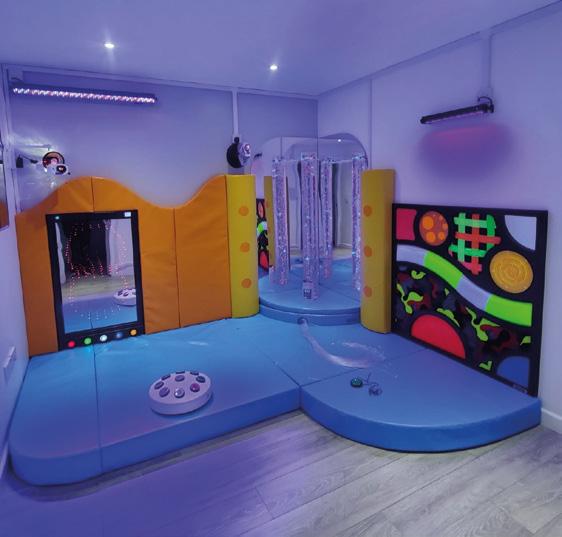
British Manufacturing
Rompa® is a proud British manufacturer based in Chesterfield, Derbyshire. Our skilled team design, create and assemble a wide range of Snoezelen® products in-house.
Rompa® provides a free 3D design of your Snoezelen® sensory room upon request. Our team will create a customised design to fit your needs and budget.
For over 35 years, Rompa® has improved lives globally and built a trusted brand. As market leaders, Rompa® offers extensive







